Birds with crests tend to look different and quickly stand out. Crests might serve as a simple evolutionary trait or may play a role in the social hierarchy or partner selection for breeding.
Various species with crests live around the world. Some of them prefer coastlines while others are even found in hot arid desert climates.
Some birds with crests are native to North America. They are abundant on coastlines as well as in the Southern states.
Migratory birds may also end up in North America to overwinter or may live on the continent for tropical overwintering climates.
Birds with crests aren’t rare, as some of the typical species that show crests both on males and females may number more than half a million birds according to the latest estimates.
The following 40 species may be spotted either in North America or around the world.
Table of Contents
1. Blue Jay
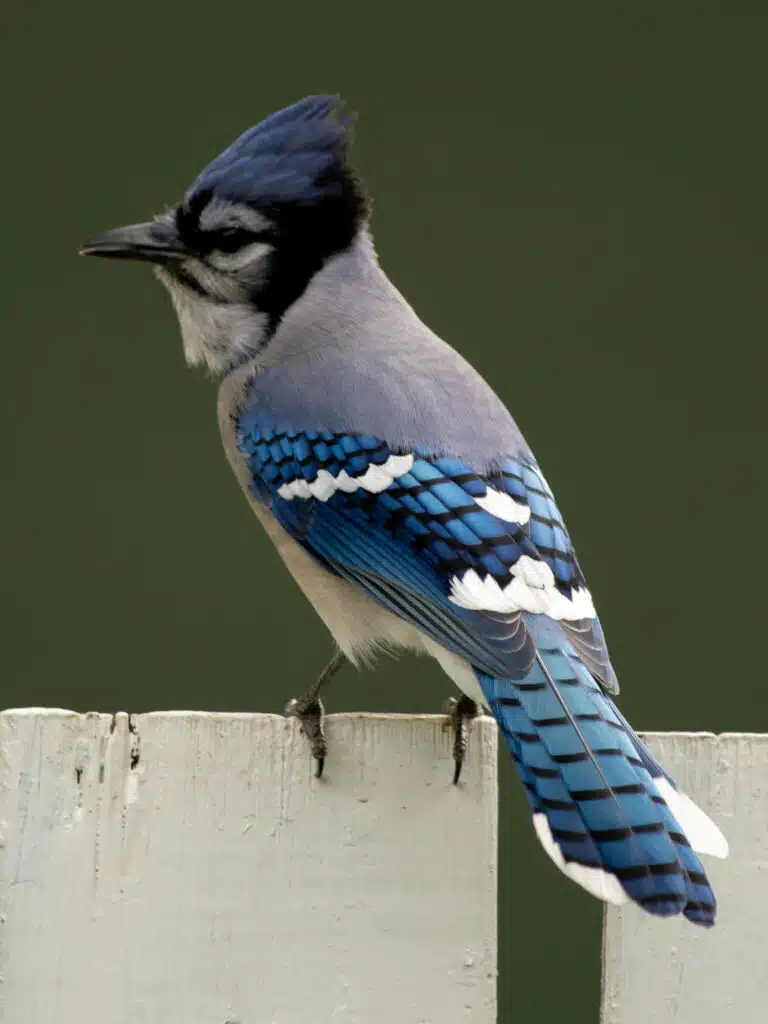
Blue Jays (Cyanocitta cristata) are among the typical North American birds with a blue crest. The crest can be elevated or flattened, depending on the activity.
Blue crests are flattened when the birds are feeding.
The crest of the species has even inspired its scientific Latin name ‘crestata’, which means ‘crested’.
Even more, the crest of the Blue Jays has even inspired cultural norms in its native range of North America with sports teams such as The Toronto Blue Jays having a crested Blue Jay head as their logo.
Birds of this species have a colorful and contrasting white and blue appearance.
Distribution – Canada, Eastern United States
Crest color – blue
2. Cedar Waxwing
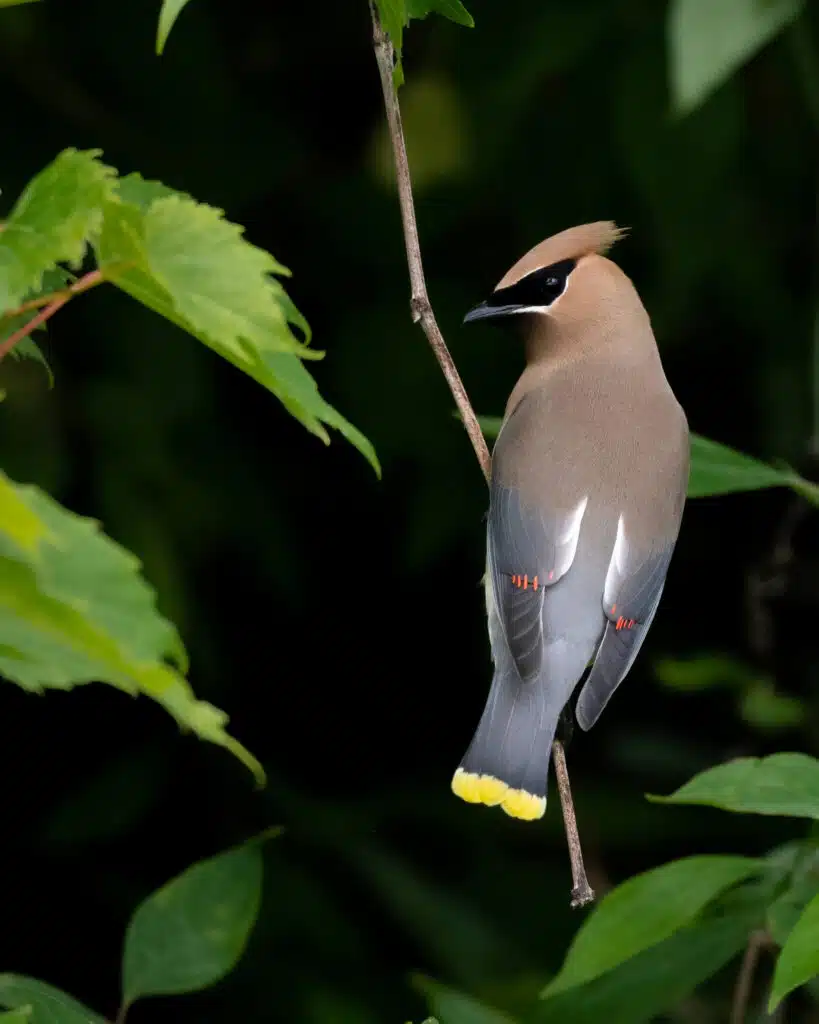
A species of cedar woodlands, The Cedar Waxwing (Bombycilla cedrorum) is a native North American species.
It lives in cedar woodlands where it can find food such as cedar cones which it feeds on, but not exclusively.
A brown and gray species with red wax-like marks on the wings, The Cedar Waxwing is a species with a visible crest.
Its bright brown crest is long and it contrasts the wide black and white band along its eyes which counties from the black beak to the sides of the head.
The species is migratory, spending most of its winters in the Southern parts of North America or in Central America.
Distribution – Canada, United States, Mexico, Belize, Nicaragua, Costa Rica, Panama, Cuba
Crest color – bright brown
3. Belted Kingfisher
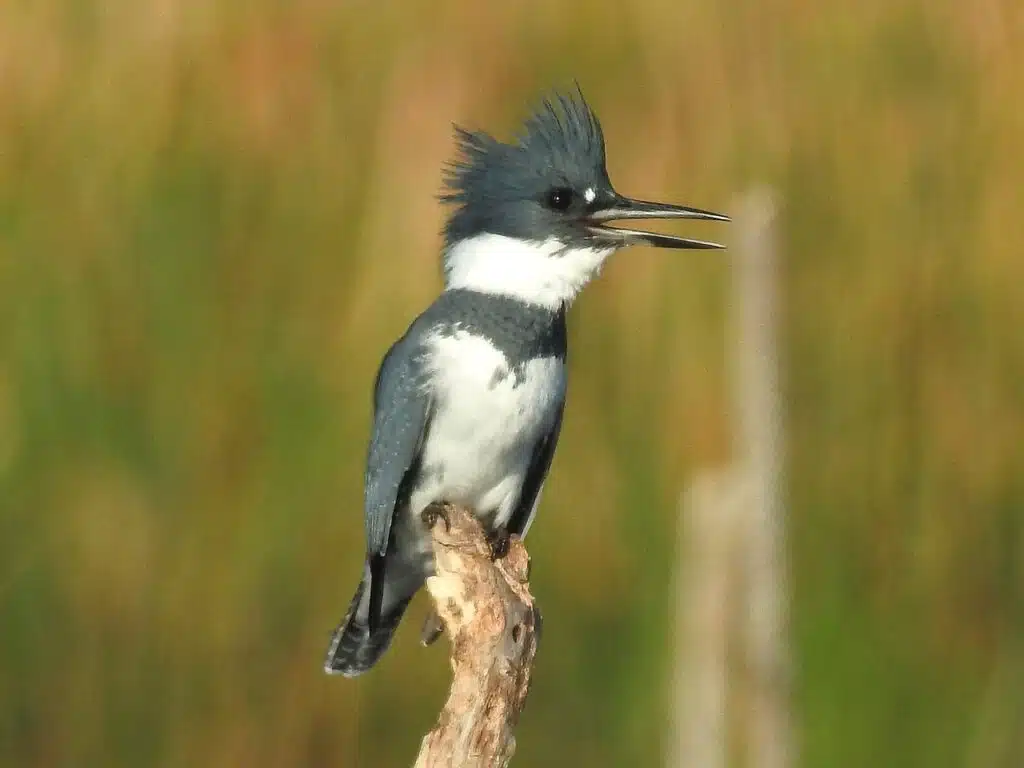
Slate blue colors and a large crest dominate the appearance of The Belted Kingfisher (Megaceryle alcyon). This is a species where both males and females show crests.
The female Belted Kingfisher is more colorful than the male, a rare trait in the world of birds where males tend to be more colorful when having different plumage to females.
The bird has a specific slate blue color, which is a type of blue with gray nuances on its head and crest.
Its wings also show a slate blue nuance with a white underbelly and a white neckband.
Distribution – Alaska, Canada, The United States, Mexico, Guatemala, Costa Rica, Panama, Cuba, Ecuador
Crest color – slate blue
4. Tufted Titmouse
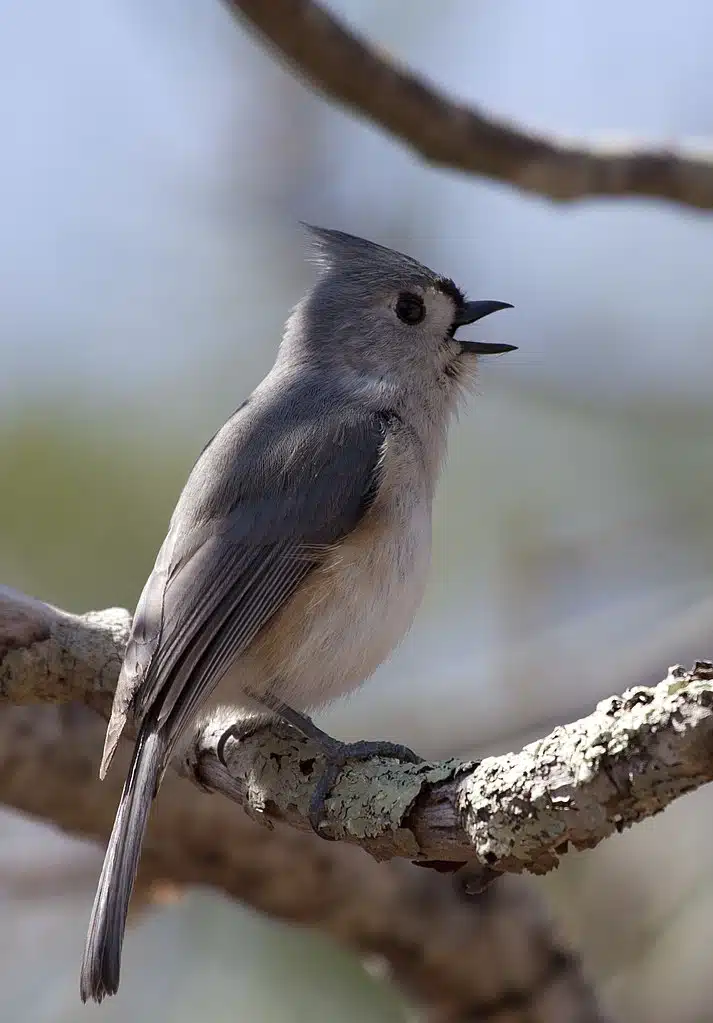
A species only found in The United States, Tufted Titmouse birds (Baeolophus bicolor) have a small gray crest.
The tufted crest makes the bird stand out, together with its nesting habits which involve repurposing holes in trees.
A base gray color is specific to the crest of the bird. Its wings and back are also gray while its beak is dark gray.
A black section is seen between its eyes while the crested bird also has white and brown-red underbelly plumage.
Specific gray colors of The Tufted Titmouse are also seen on its legs.
This singing bird eats fruits and insects on the ground and those it finds up on trees.
Distribution – Eastern US
Crest color – silver-gray
5. Pileated Woodpecker
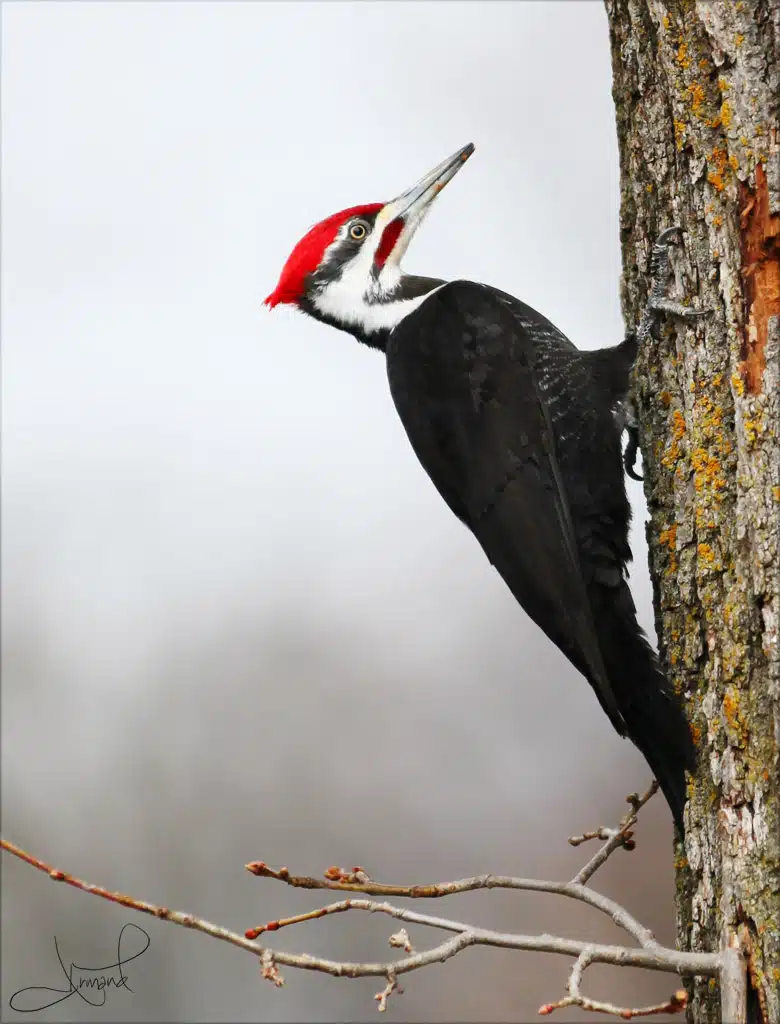
Woodpeckers are among the most common birds in North America when it comes to crested species.
The Pileated Woodpeckers (Dryocopus pileatus) stand out with a red head and crest. This species has black and white colors across its wings and belly which means its red head stands out even more.
The crest of the species is descriptive of the woodpecker to the extent its name is inspired by it. A type of cap is the Latin root name of the Pileated Woodpecker.
The species is seen both across Canada and The United States. Eastern US territories and Western US territories are home to the species.
In Canada, the woodpecker is found across the country, mainly in its warmer Southern territories.
Distribution – Canada, Eastern US, Western US
Crest color – red
6. Hooded Merganser
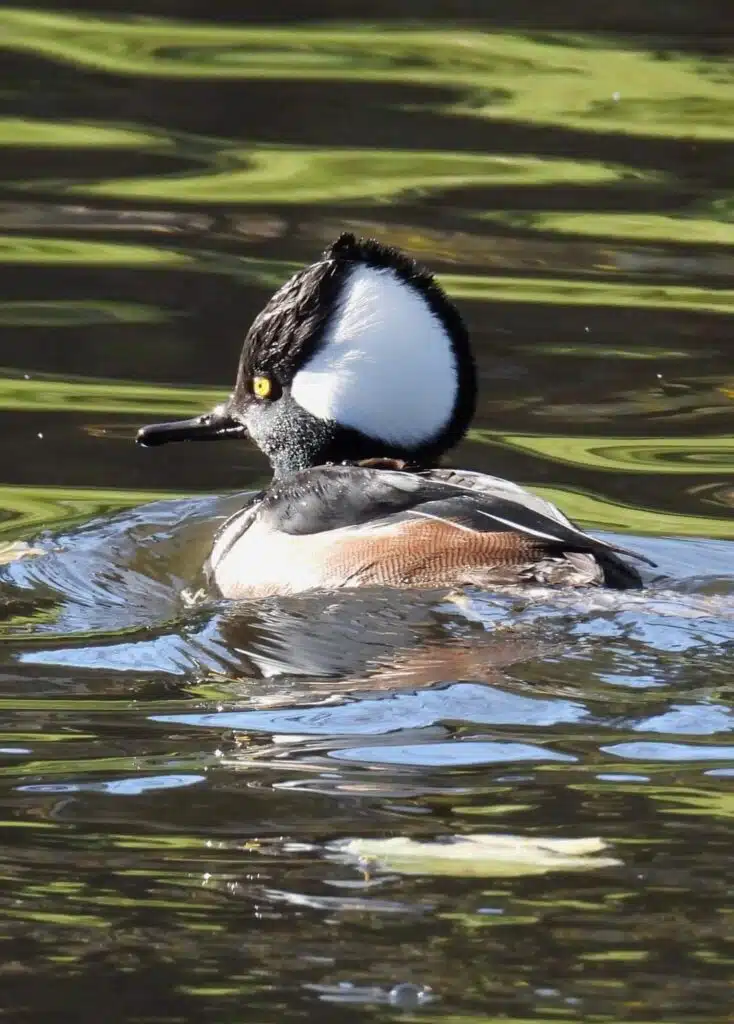
Both male and female Hooded Mergansers (Lophodytes cucullatus) have crests.
Black and white heads with crests are specific to males while females have brown heads with crests.
Their tufted crested are fully controllable which means they can be raised or lowered, depending on the season or the activity.
One time the crest of the species is elevated is during the courtship period.
Males are dominated by black and white heads, back, and wings while females are mostly brown. Their crests also have similar coloring.
They impress each other with their crests and remain together after breeding until the eggs are laid by the female.
Distribution – United States, Southern, and Western Canada
Crest color – black, brown
7. Steller’s Jay
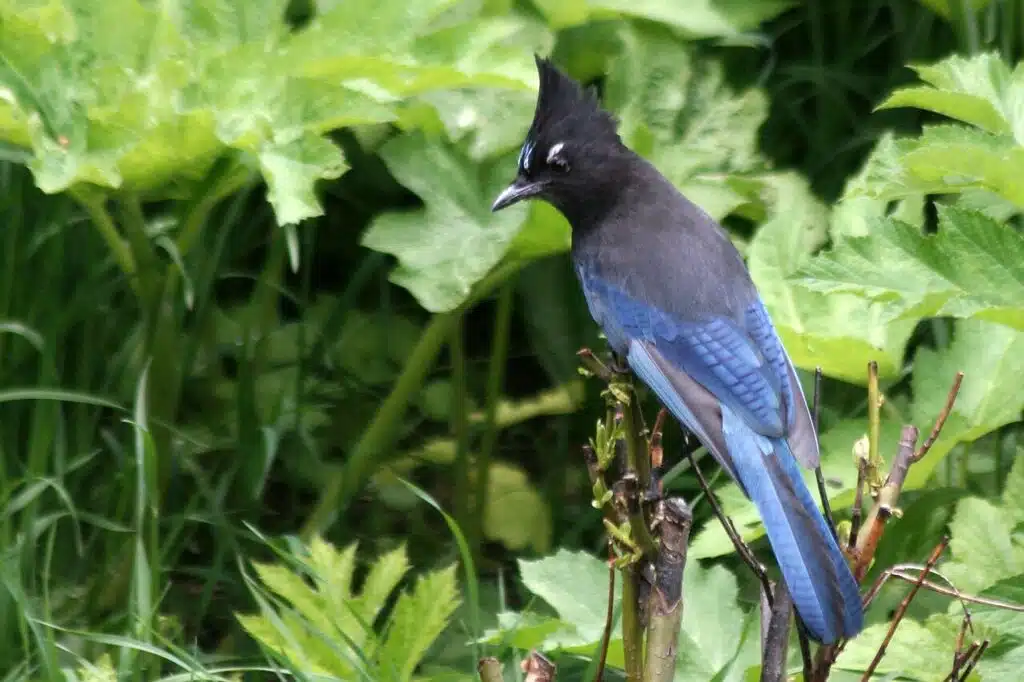
One of the most common crested birds in North America that has more than 10 subspecies is Steller’s Jay (Cyanocitta stelleri).
This bird has a tall crest which may be black or even blue. A black crest with blue frontal streaks is specific to these birds.
The crest of Steller’s Jay is different, depending on the region.
Some of the northern US and Canadian populations have taller crests. Steller’s Jays are also birds that have a widespread habitat West of The Rocky Mountains.
They are found in a widespread habitat from California to Alaska in pine, oak, or mixed woodlands.
Distribution – Western North America
Crest color – black, black and blue
8. California Quail
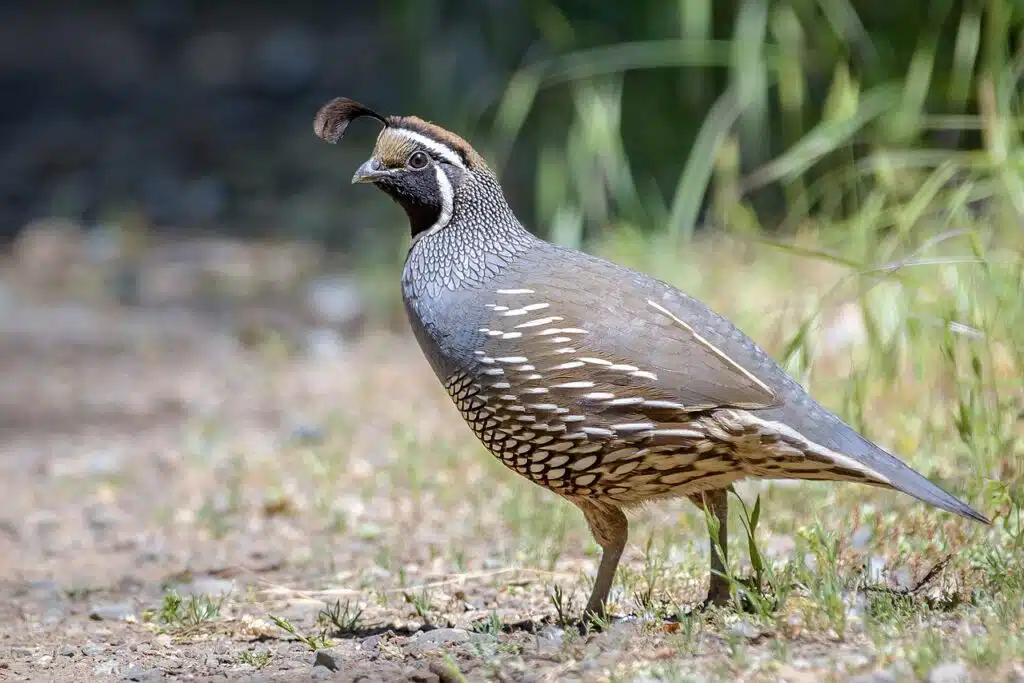
California Quails (Callipepla californica) are known for their long comma-shaped crests.
These birds spend much of their lives on the ground and they have an elevated crest that leans forward.
Some variability is specific to this crest, including its size and color.
The crest is black on darker males. Female California Quails are brighter and have a brown crest.
Geographic variability also influences the size of the crest. Birds in the Southern parts of the habitat around California have longer crests.
Distribution – Western US, Southwestern Canada, Baja California
Crest color – black, brown
9. Red-breasted Merganser
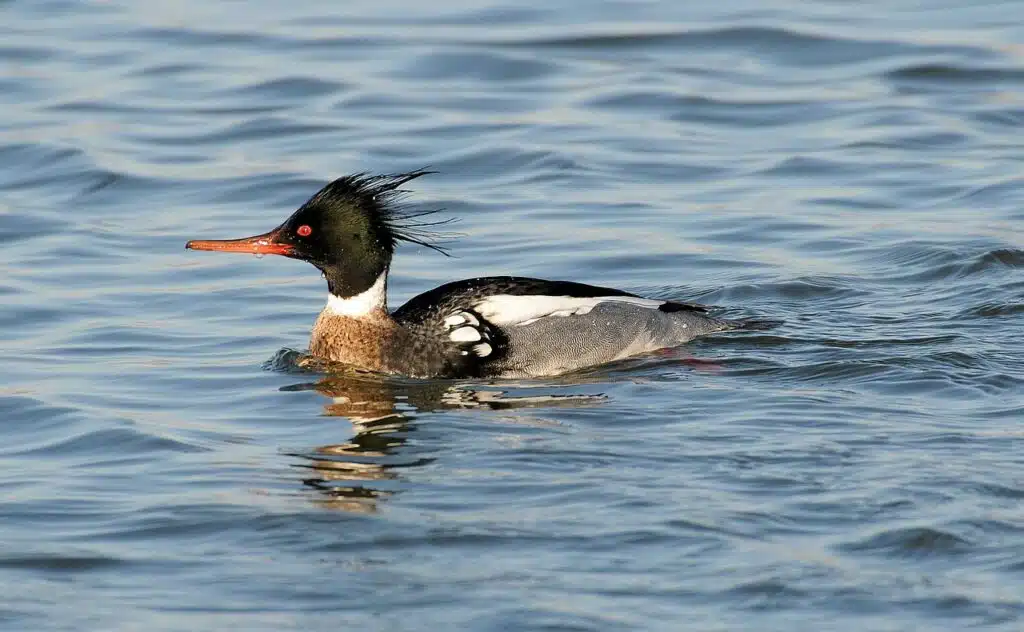
Red-breasted Mergansers (Mergus serrator) are named after their colorful underbellies during the breeding season.
Ducks of the species show specific crests on males and females.
These ducks have a black crest on males and a gray-brown crest on females which may be raised or lowered.
A spiked shape is specific to these crests and it may be used as a breeding signal.
Red-breasted Mergansers are found on multiple continents. The ducks are good divers, going underwater for fish.
These types of ducks are known to migrate to overwintering before returning to their breeding locations.
Distribution – North America, Europe, Asia
Crest color – black, gray
10. Greater Roadrunner
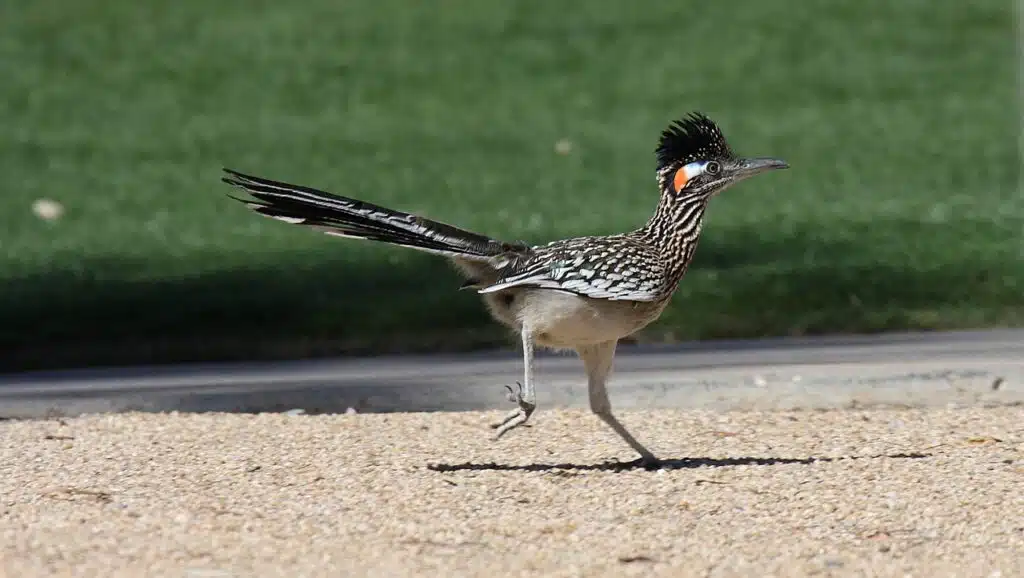
Growing to a size between 17 and 24 inches, Greater Roadrunners (Geococcyx californianus) are primarily known for their speed.
These birds can run fast, reaching a top speed of around 20 miles per hour.
A small crest is seen on this streaked bird.
Its black crest can be raised or lowered, just as with most crests.
The position of the head also influences how the crest looks. Greater Roadrunners have very specific running positioning.
Heads and tails are positioned in a straight parallel line for better running aerodynamics.
Distribution – Southern United States, Mexico
Crest color – black
11. Royal Tern
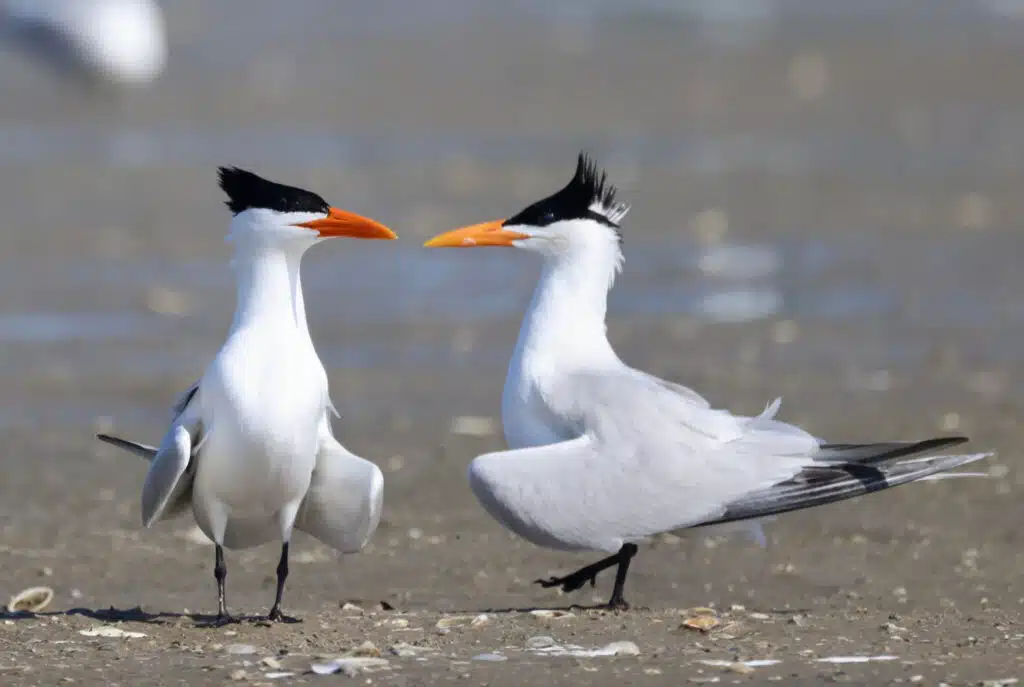
A black crest is characteristic of Royal Terns (Thalasseus maximus). This is a black and white tern with additional bright gray coloring on the wings.
A species of The Americas, Royal Terns spend much of their time out at sea, particularly around Central America.
These birds are seen in small numbers on beaches, areas where they may nest and breed.
This crested species is rarely seen on its own, as it mixes with other types of seabirds.
Distribution – North America’s East Coast, Coastal areas of Central America, The Caribbean, coastal areas of Northern South America
Crest color – black
12. Golden-crowned Kinglet
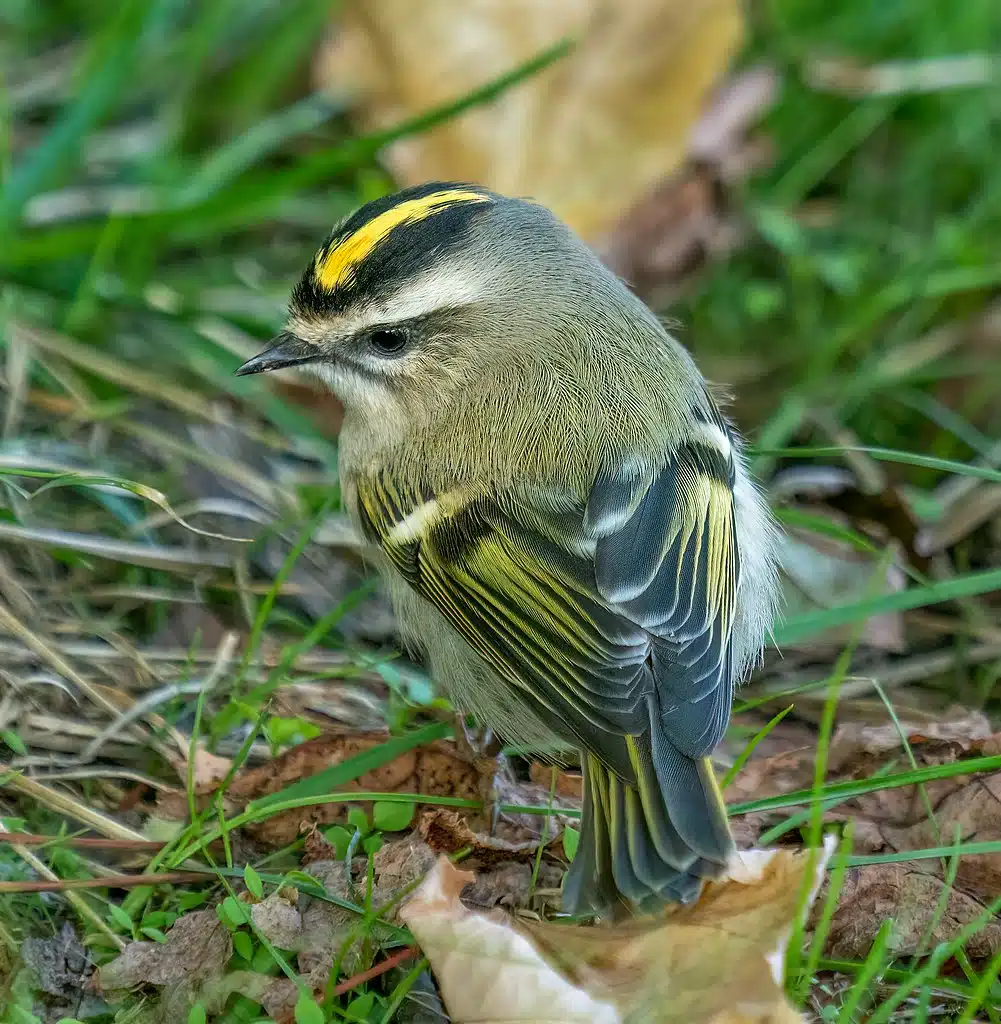
Golden-crowned Kinglets (Regulus satrapa) are seen as either North American warblers or European-origin warblers by various studies.
Regardless of their origin, these small birds stand out with their short yellow crests and gray-black head color.
A vivid yellow crest on the species makes them stand out. This crest even inspires the name of the bird, even if the nuance of the crest is bright yellow and rarely golden-yellow.
The crest is also a trait of adults and a sign of coming to adulthood as juveniles don’t have a crest yet.
Distribution – United States, Canada
Crest color – yellow
13. Phainopepla
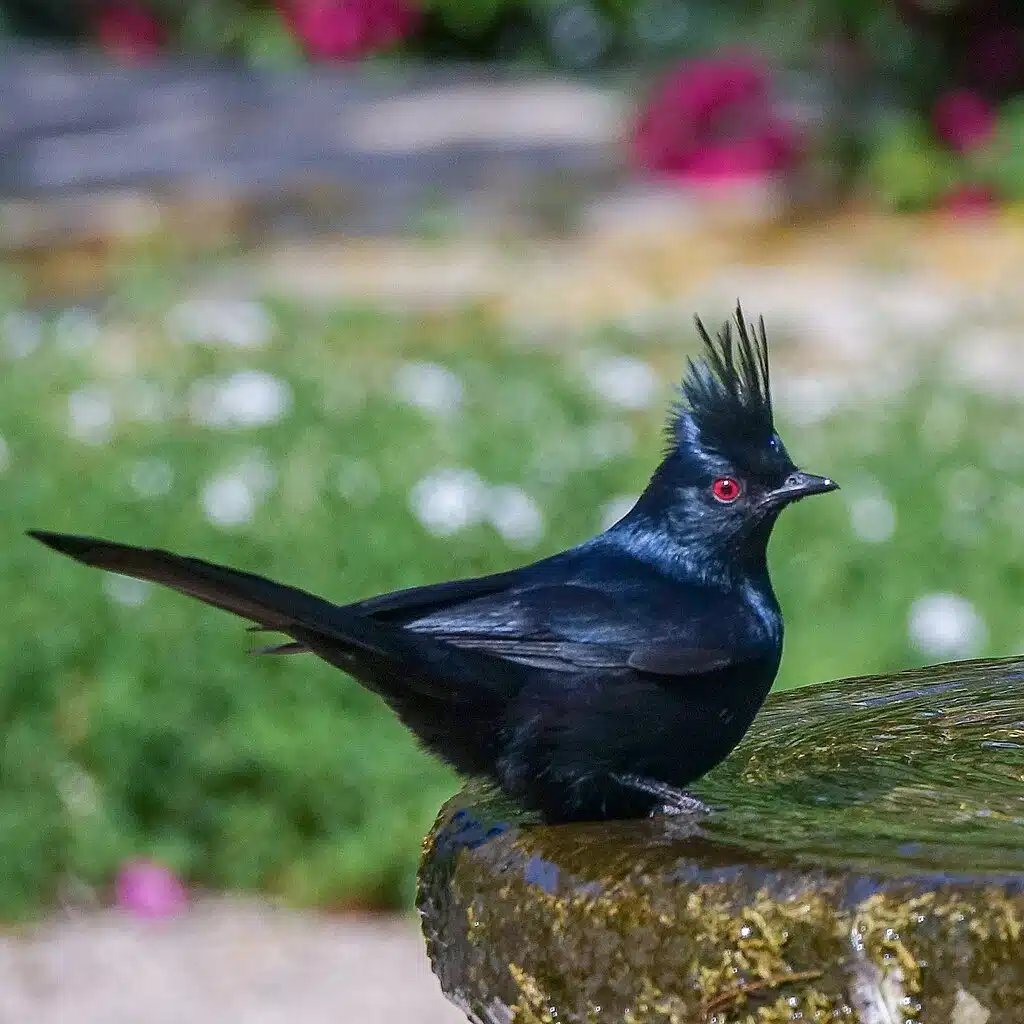
A movable crest that can be elevated or lowered is specific to both male and female Phainopeplas (Phainopepla nitens).
These birds show sexual dimorphism, a characteristic that separates the look of the male from the look of the female.
Male Phainopeplas are mostly black, with a black crest.
Females are gray, with a matching gray crest.
Also known for their long tails, Phainopeplas have either black or gray tails.
The color of the male is a bit shiny or glossy, which also inspires the scientific name of the species.
Distribution – California, Arizona, New Mexico, Mexico
Crest color – black, gray
14. Gambel’s Quail
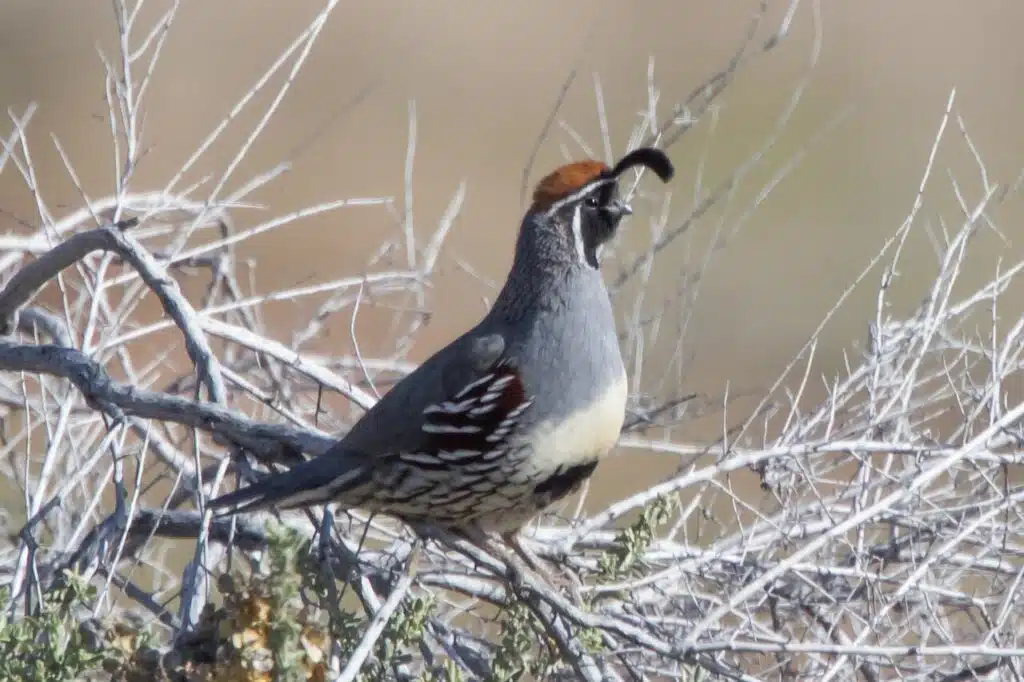
Plumage differences are seen in male and female Gambel’s Quails (Callipepla gambelii).
While differently colored, both male and female birds of the species have black crests. These are comma-shaped crests that are slender, long, and curved forwards.
The black comma is matched by a black face in the case of males. Gray plumage with brown wings is specific to the species.
Females are also dominated by gray plumage but have gray faces and not black faces as males.
Distribution – California, Arizona, Nevada, New Mexico, Mexico
Crest color – black
15. Indian Peafowl
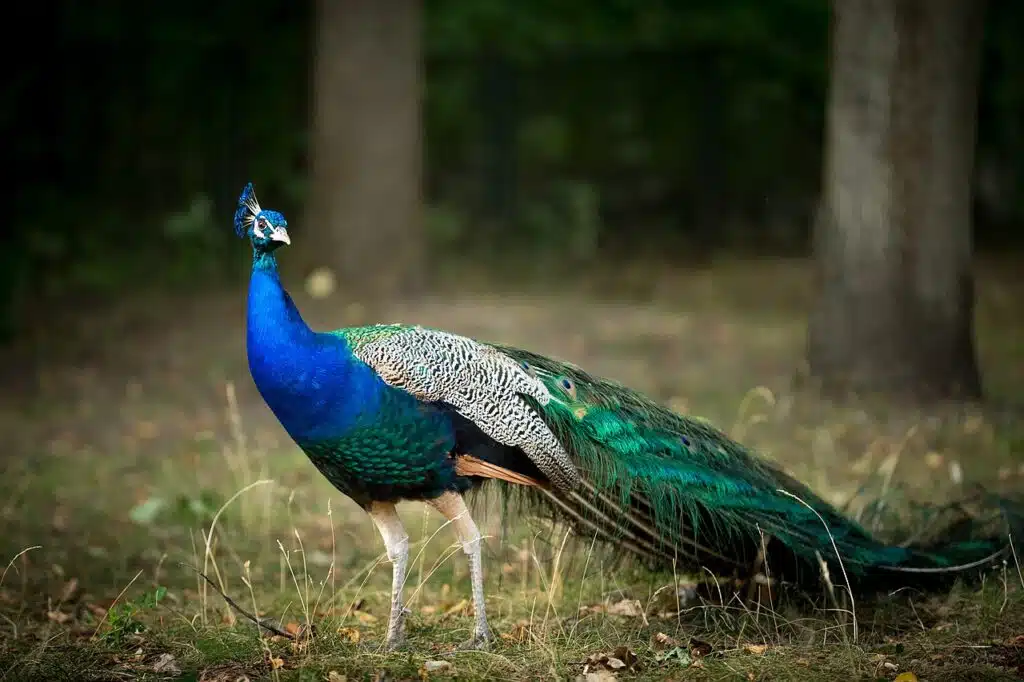
Indian Peafowls (Pavo cristatus) are some of the most decorated birds in the world. They are known for their fan-shaped feathers which they can raise up during courtship.
These large multicolored birds also have fan-shaped crests.
Some differences are specific in the coloring of the males and females, particularly on the feathers with eyespots.
On the other hand, both males and females share a similar-looking fan-shaped crest.
This crest may be black, blue and black, or even white on white Indian Peafowls.
The colors of the feathers and the crown may play a role in the selective breeding of the females.
Distribution – India
Crest color – black, black and blue, white
16. Black-crested Titmouse
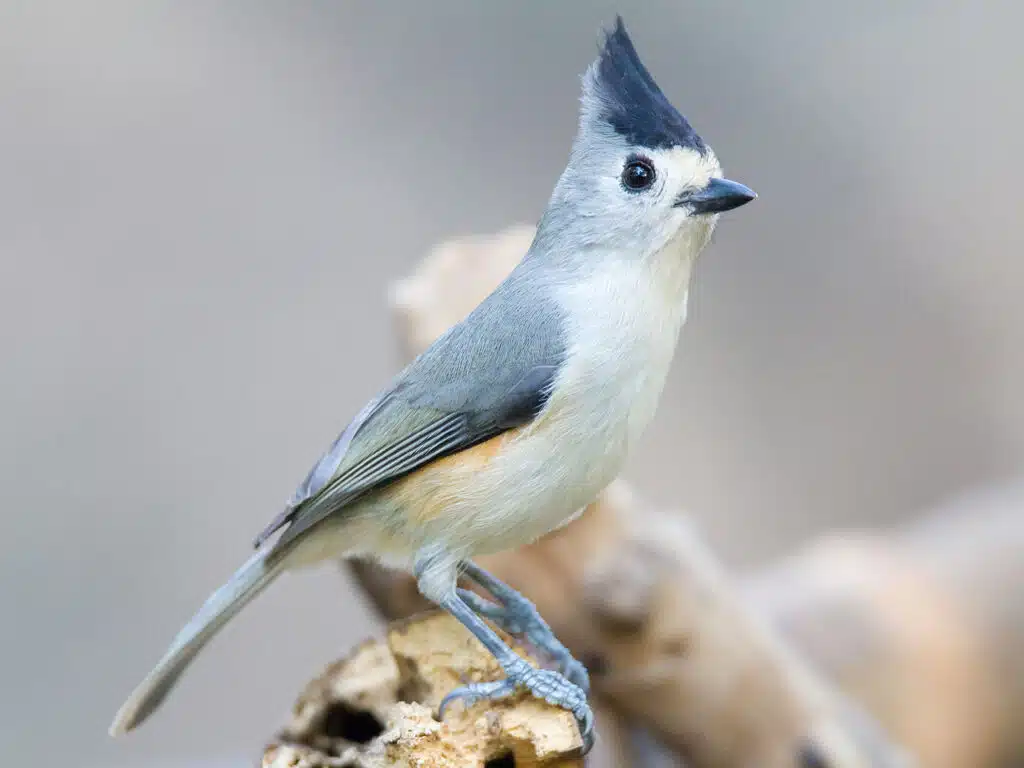
A species of the Southern US territories, Black-crested Titmouse birds (Baeolophus atricristatus) are named after their long black crests.
However, the name of the species is derived from the crest color of males as females have a gray crest.
The erect crest of males is contrasted by a bright gray body with an almost white underbelly.
Females are also gray, with a gray head, crest, and underbelly. Darker nuances color their wings.
A type of species found on different types of trees, Black-crested Titmouses have a specific repetitive nature song.
Distribution – South Texas, Mexico
Crest color – Black, gray
17. Red-crested Cardinal
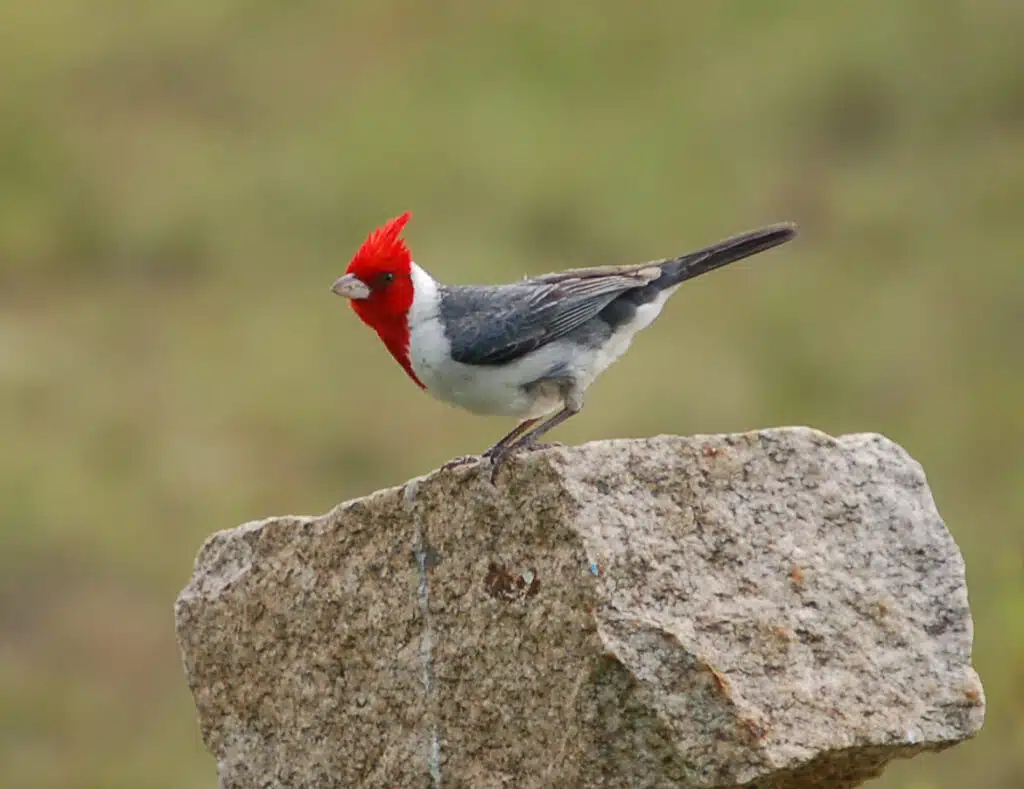
Named after its vivid red crest, The Red-crested Cardinal (Paroaria coronata) is among the most common types of crested species with a multicolored appearance.
Both its head and its crest have a vivid red color. Red nuances also cover its neck while its body and underbelly are mostly white.
Gray and black wings are specific to this species of cardinal.
While both males and females have a red crest, females are dull-colored and have a brown-red crest and head.
Spending much of its life on the ground, Red-crested Cardinals are native to South America.
Distribution – Bolivia, Paraguay, Uruguay, Argentina
Crest color – red, brown-red
18. Sandwich Tern
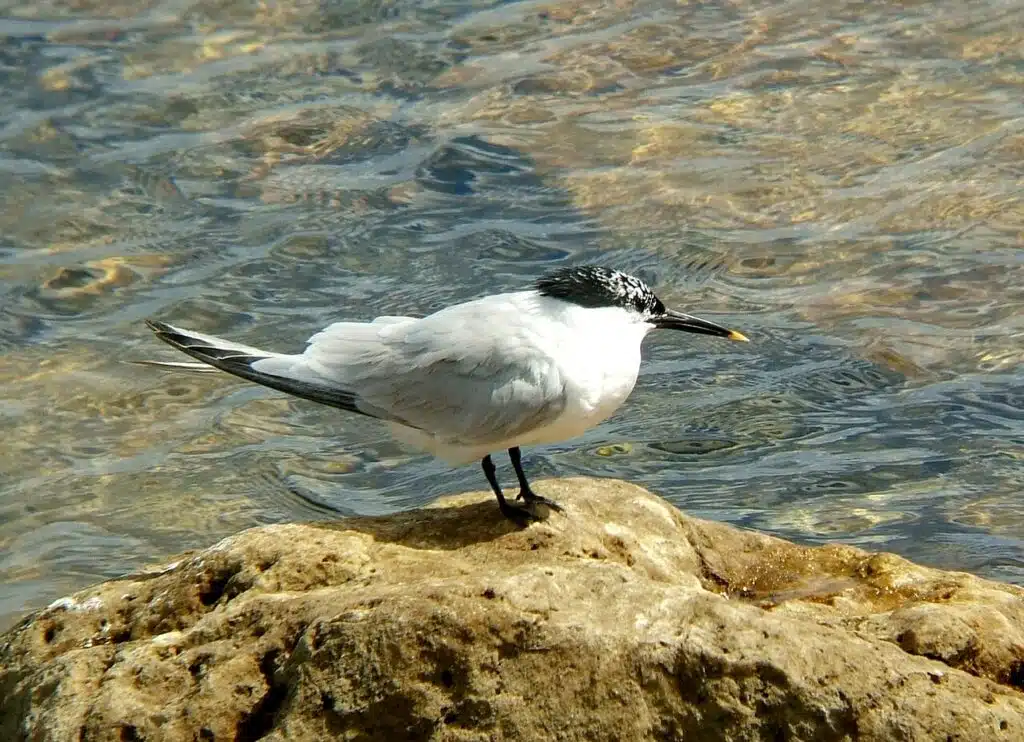
Sandwich Terns (Thalasseus sandvicensis) show a black crest in the breeding season and a white crest and crown in the winter.
These terms are primarily white. Their wings have a pale gray color that almost appears white.
Black coloring is only seen on the crest and crown of the species in the breeding season. A yellow beak contrasts the black-and-white appearance of the species.
Black and white color combinations mark its lifespan as the species lays most off-white eggs with black speckles.
The size of the tern is variable but most Sandwich Terns don’t grow larger than 17 inches.
These birds are known for plunging after fish and their numerous presence around the world.
Up to half a million Sandwich Terns are confirmed around the world.
Distribution – Coastal areas of The Americas, Europe, Africa, and The Middle East
Crest color – black, white
19. Elegant Tern
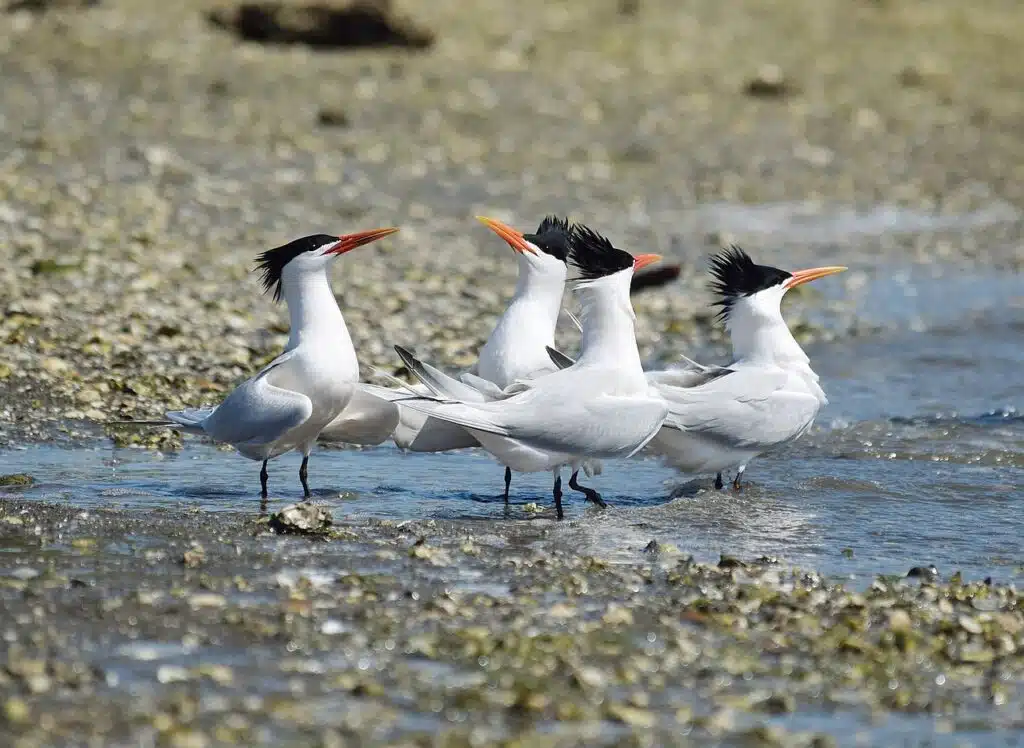
Black, white, and gray plumage is specific to this type of tern (Thalasseus elegans).
Its black crest is continued with a black crown and black face coloring around the eyes and to the beak.
Its head, neck, and back are white while its wings show pale gray coloring.
Much of its flying abilities are also adapted to diving. This species feeds on ocean fish.
Its range is limited to coastal habitats where it dives for fish and where it lays eggs on the beach.
The species is believed not to migrate even if it has been spotted away from The Americas on a few occasions before.
Distribution – US West Coast, Western Central American Coast, Western South American Coast
Crest color – black
20. Pyrrhuloxia
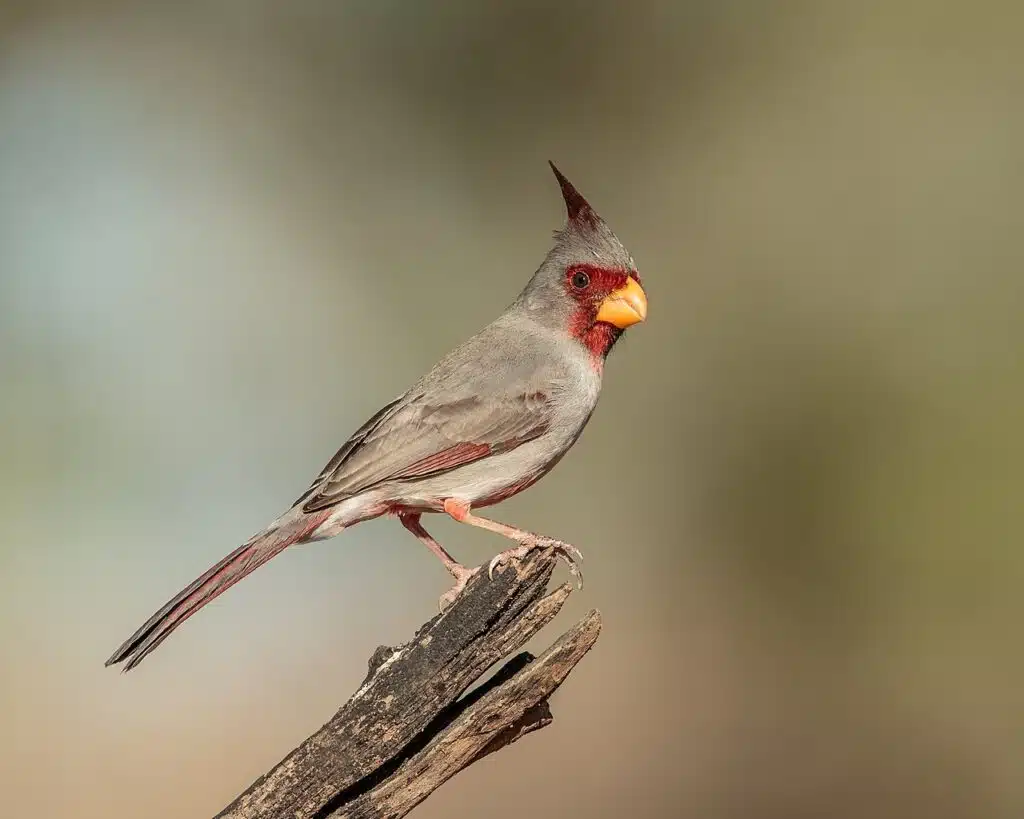
Crests are specific to male and female Pyrrhuloxias (Cardinalis sinuatus). The color of the crest differs from red to gray.
Males are more colorful, particularly in the breeding season. This is when they show a red crest with additional red sections on the margins of the wings and on the tail.
A bright gray color is specific to these birds.
The bright red nuances may be spotted on the crest and underbelly of males in the breeding season, which starts in March.
Birds of the species remain a resident species in the warm Southern climates of The United States.
Distribution – South Arizona, South New Mexico, South Texas, Baja California, Mexico
Crest color – red, gray
21. Red-whiskered Bulbul
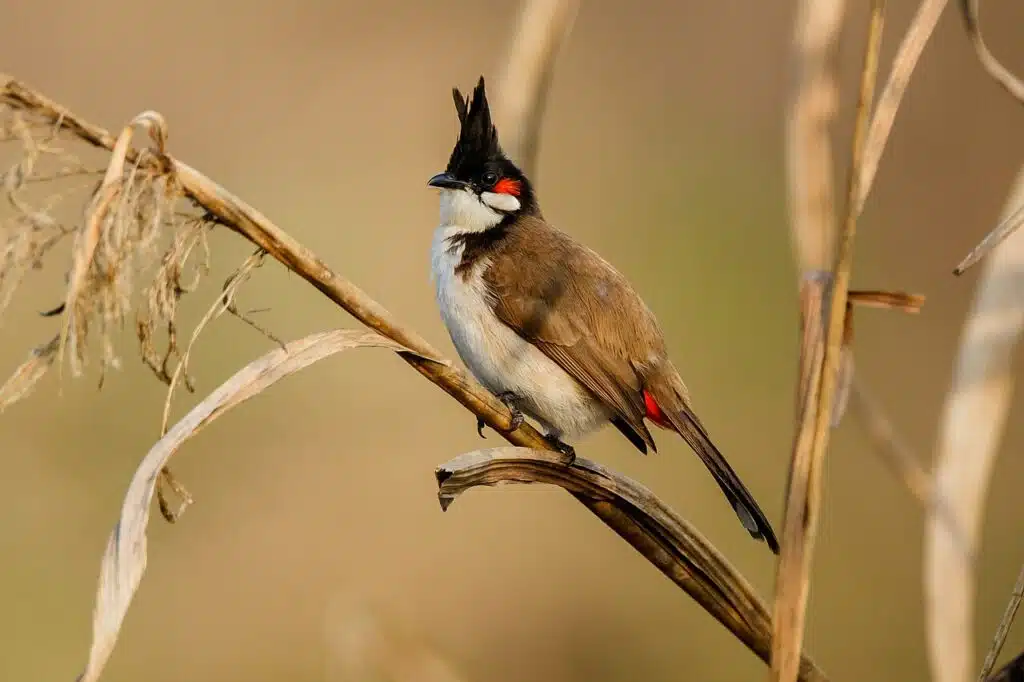
There are 9 Red-whiskered Bulbul Subspecies (Pycnonotus jocosus) with long or short crests.
A black crest is specific to this species with a black crown. Its face is white with red marks on the sides and with a black beak.
Bright brown feathers are seen on its wings and tail while its underbelly is white.
A species native to Southeast Asia and Southern Asian territories, Red-whiskered Bulbuls are often spotted and heard in gardens.
They have a 3-tone song and have been introduced and established in North America.
Distribution – India, Thailand, Vietnam, Bangladesh, California, Hawaii
Crest color – black
22. Bohemian Waxwing
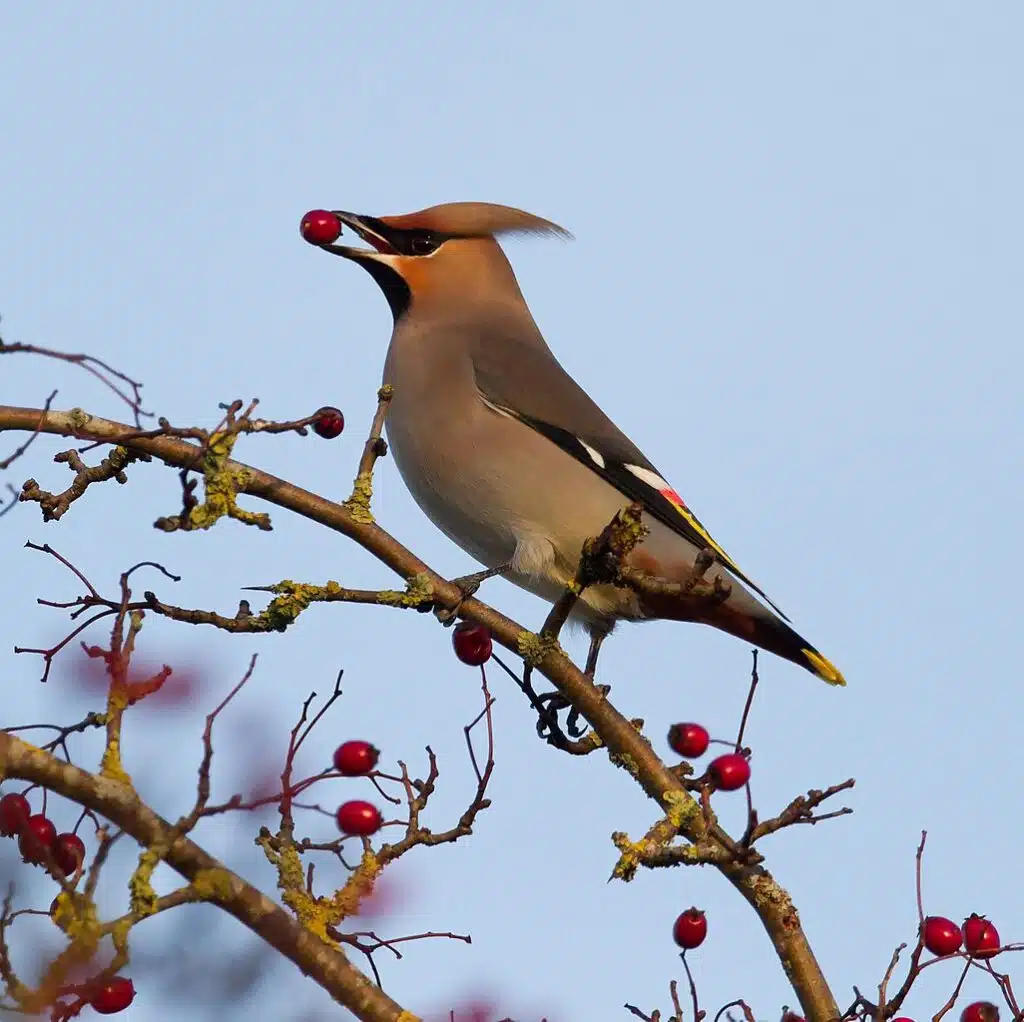
A gray species with red nuances, The Bohemian Waxwing (Bombycilla garrulus) has a gray crest.
Its beak is black, as are its wings. Yellow, red, and white spots are also seen on the margins of its wings. This species is known for its rust-red colors which cover its face, neck, and the ventral side of the tail.
Bohemian Waxwings may overwinter in their breeding climates. They often survive on fruits they can still find in the cold months.
However, most of its flocks migrate to Southern territories of the world, including to The United States for the populations in North America.
They also eat fruits and seeds throughout the year.
Distribution – North America, Europe, Russia
Crest color – gray
23. Red-vented Bulbul
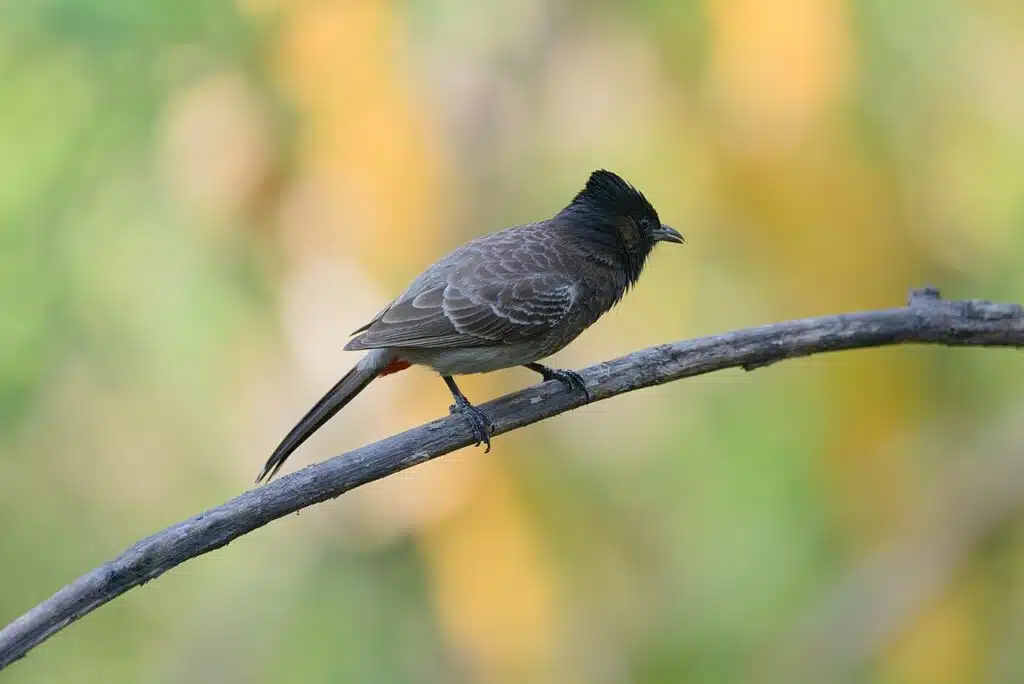
A species that feed on fruits and insects, Red-vented Bulbuls (Pycnonotus cafer) have a black crest.
Both males and females have a black head and a black crest while their body is gray and white.
The rump of the species is also white and red.
Females are generally darker. They are dominated by dark brown nuances and bright brown nuances as opposed to bright gray specific to the underbelly of males.
Distribution – India, Bangladesh
Crest color – black
24. Juniper Titmouse
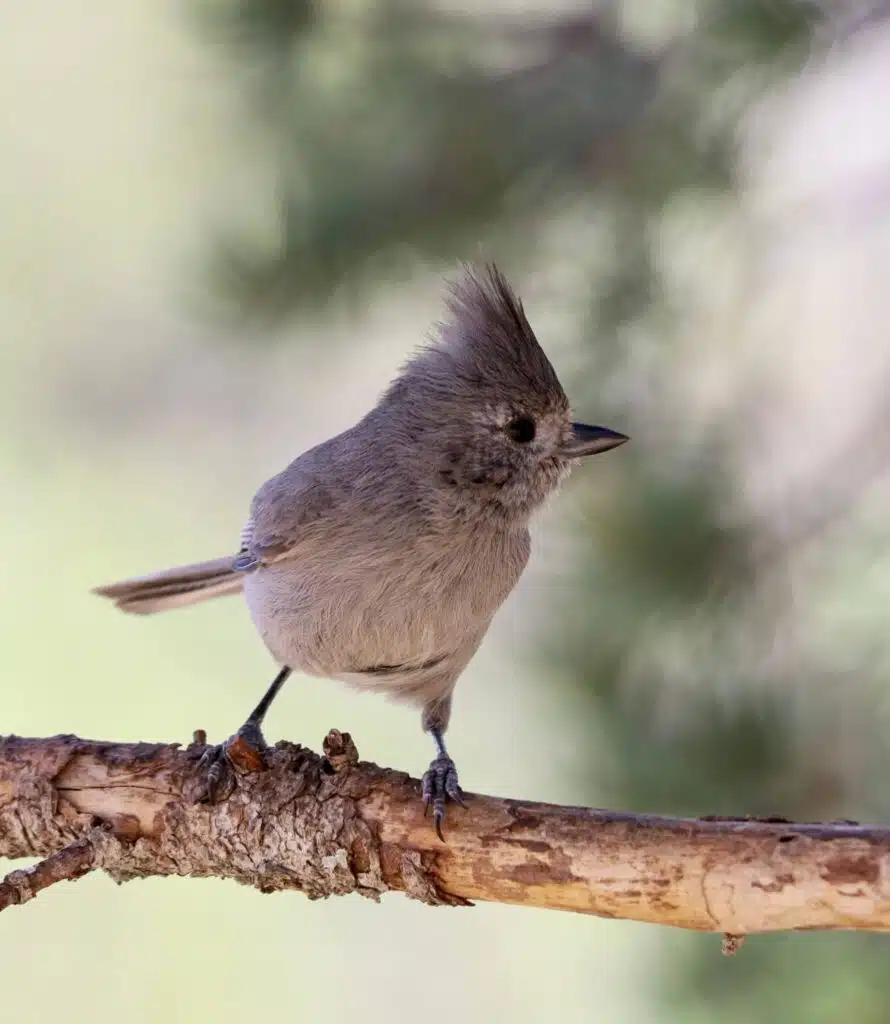
Juniper Titmouse (Baeolophus ridgwayi) is named after the juniper woodlands they inhabit.
Birds of this family are found in North American juniper woodlands where they feed on insects, fruits, and seeds.
Both males and females are dull-colored, which isn’t common in the world of birds with crests.
A bright gray color dominates their entire appearance, including the crest.
Slightly darker gray nuances are specific to the wings and the crest of the birds while their legs and beak are dark gray to black.
Mostly spotted around The Southwestern United States, this is also one of the birds which can feed while hanging upside down.
Distribution – California, Arizona, Mexico
Crest color – Gray
25. Bridled Titmouse
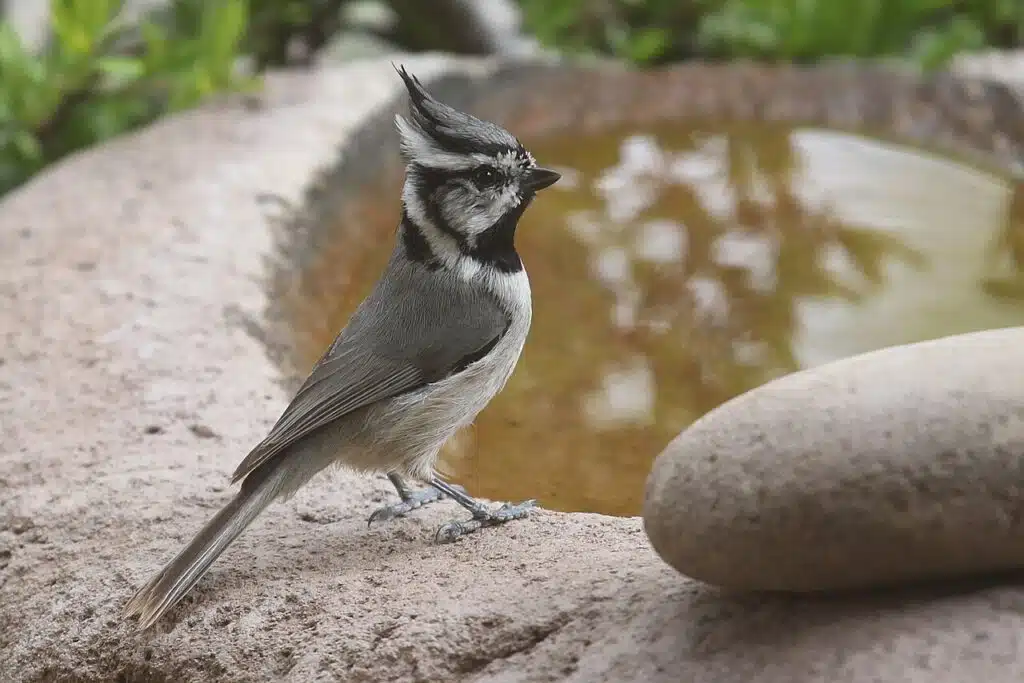
A species of the South, Bridled Titmouse birds (Baeolophus wollweberi) have multicolored crests and heads.
This is a species with a black and white head and a matching crest. Bridled Titmouse birds have patterned faces with black and red swirls.
Bright gray and dark gray plumage completes their appearance.
The species is found in different habitats. It can adapt to riparian areas or in pine or hardwood woodlands.
It shares the same tree with other species often repurposing nests and holes in trees for its nests.
Distribution – Arizona, Mexico
Crest color – black, white
26. Brown-crested Flycatcher
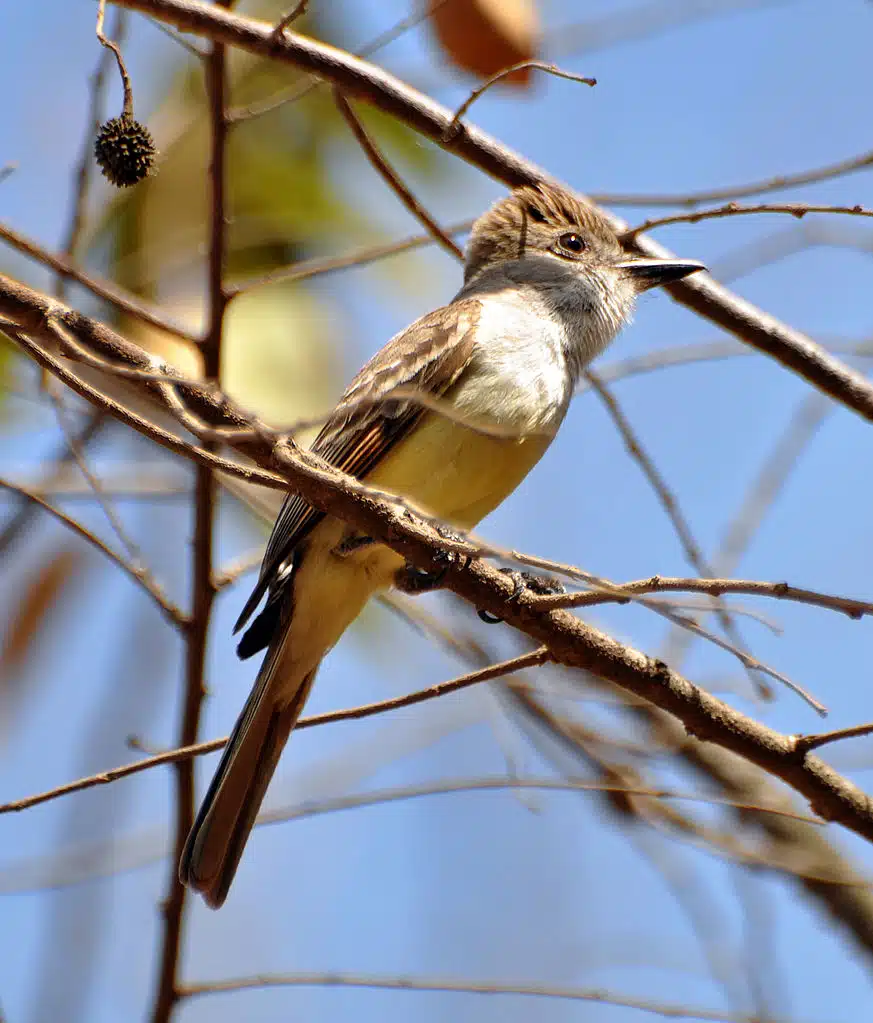
A species found across The Americas, Brown-crested Flycatchers (Myiarchus tyrannulus) have large brown fluffy crests.
The size and even the nuance of the crest are variable.
This is also a species with variable plumage, in general, It may have a yellow chest and even a blue chest with a yellow underbelly.
Its wings are dark brown and similar in nuance to the crest itself.
Migratory species of Brown-crested Flycatchers are only specific to The United States where they overwinter in the Southern states.
Brown-crested Flycatchers are generally resident birds and they feed mostly on insects.
Birds of the species repurpose old holes in trees or other types of holes out in nature for their nests.
These nests as well as their habitat are highly variable but most are found up on trees. In The United States, Brown-crested Flycatchers breed in open areas of woodlands.
Distribution – Arizona, Texas, Florida, Central, and South America
Crest color – brown
27. Black-throated Magpie-Jay
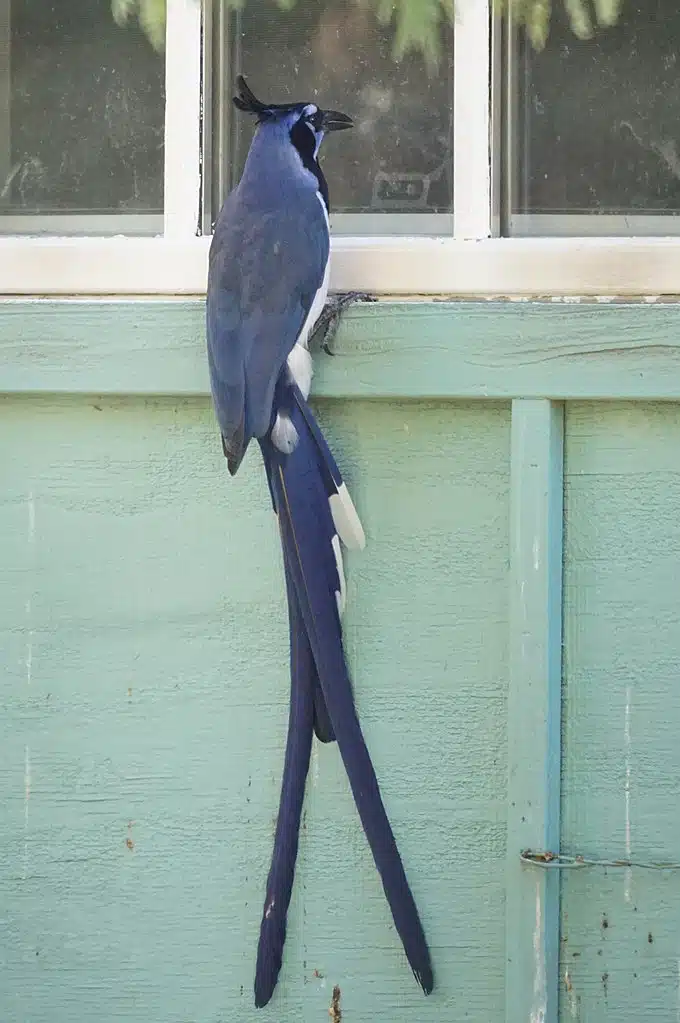
A long crest and a long tail are the main distinctive traits of The Black-throated Magpie-Jay (Calocitta colliei).
A black feather-like crest is seen on these birds, which also have a black face and a dark beak.
Dark blue wings, backs, and tails are also seen on these birds only brighter on the underbelly.
Humid woodlands are among the preferred habitats of the species. Despite its very large size of up to 30 inches, it may not be easily spotted as it lives on its own or in pairs up on trees.
The preferred woodlands of the species are those in Northwestern Mexico.
Its presence in The United States is sporadic but growing.
Some of the established Black-throated Magpie-Jay populations are found in The Tijuana River Valley, an area just outside San Diego on the US-Mexico border.
Distribution – Mexico, California
Crest color – black
28. Tufted Duck
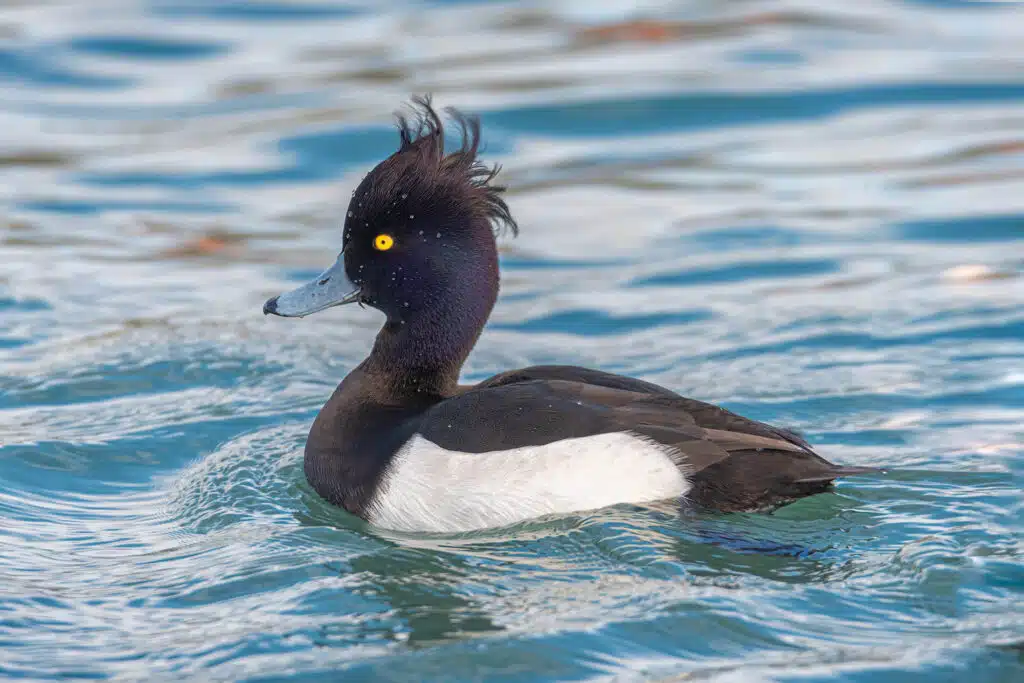
Tufted Ducks (Aythya fuligula) have a thin crest that is not on the crown but at the back of the head.
This black crest is a trait of males and is not visible at all on females, which are even differently colored.
Males are mostly black, as are their crests. This is a species with black wings and a white underbelly.
Females are less contrasting and dominated by brown-chestnut nuances.
Both males and females have a pale blue beak.
These types of ducks are divers, feeding on different types of ocean fish. They are also migratory.
Wintertime makes the period when Tufted Ducks arrive on The American East Coast before heading back to their breeding sights in Europe.
These ducks are also migratory in Asia, where they prefer to look for warmer marshes and coastlines before returning to their breeding sites.
Distribution – Europe, Eastern North America, Southern and Eastern Asia
Crest color – black
29. Ringed Kingfisher
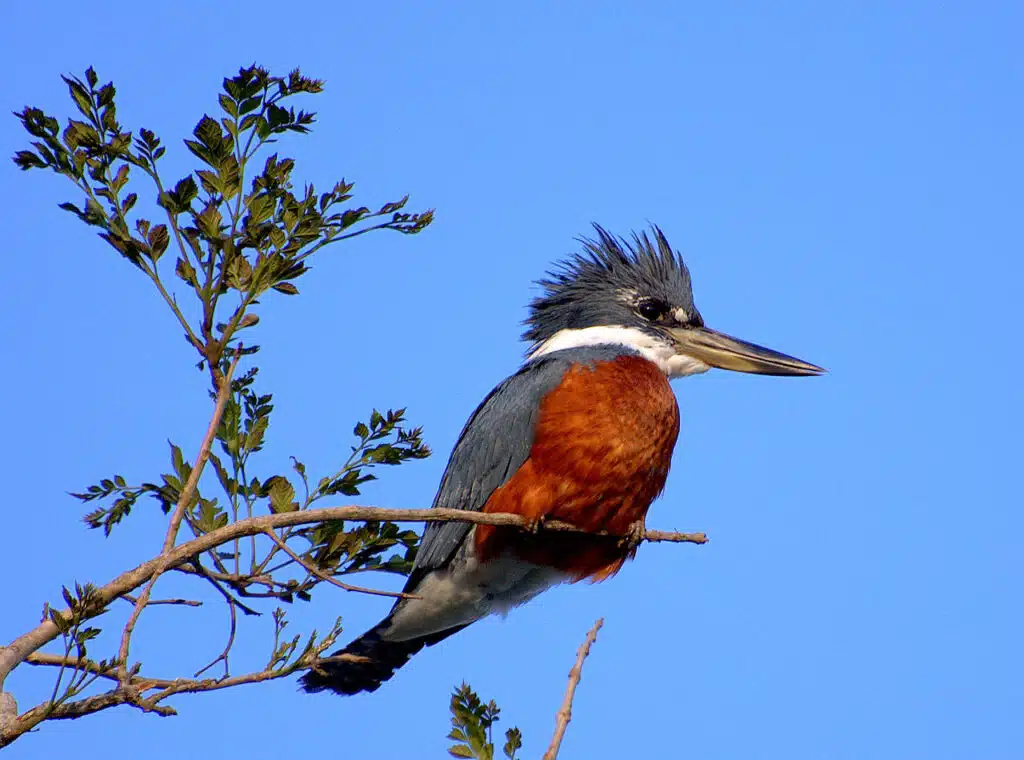
A rare sight in North America, Ringed Kingfishers (Megaceryle torquata) are among the few small birds with a dark brown underbelly and a brighter gray head and wings.
Reaching a maximum size between 7 and 8 inches, Ringed Kingfishers are also known for the crest males exhibit. This is a gray crest, matching the color of the head.
A white neckband is also visible on males while females exhibit blue-gray neck coloring.
These birds live next to water and eat fish. They also use fish as gifts during their complex mating rituals.
Males learn to fly and dance in front of females while also offering them fish.
While the species can be found in open waters, the female always looks for a retreated area to lay the clutch in.
These types of birds feed mostly on fish, but may also eat crabs and shrimp.
In turn, they are also prey for different large predators such as hawks.
Distribution – Texas, Central America, South America
Crest color – gray
30. Northern Lapwing
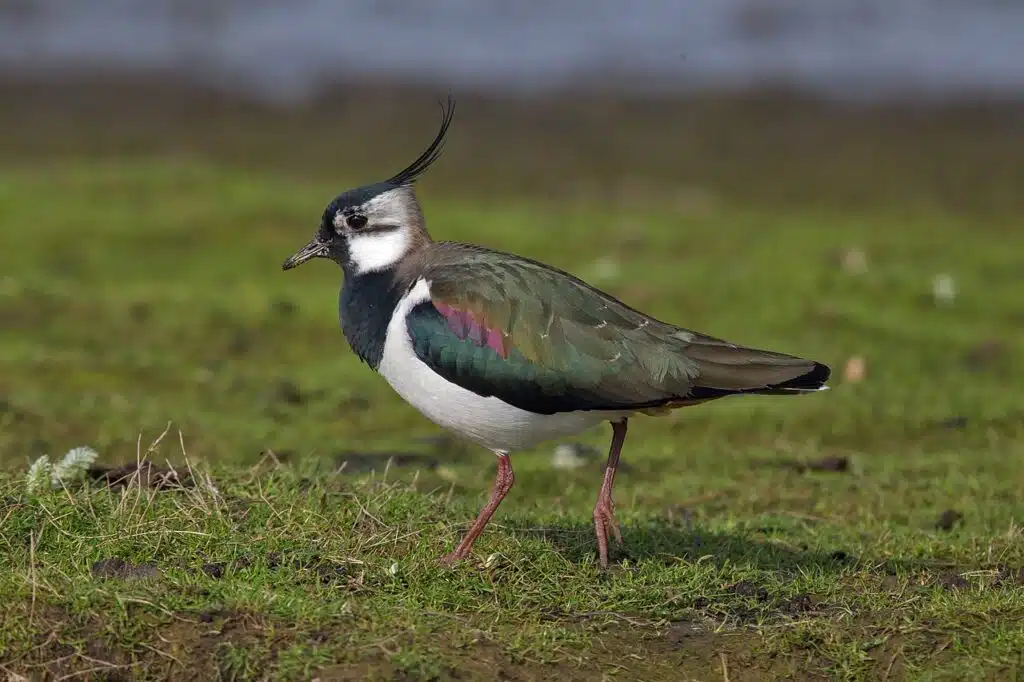
A type of European lapwing, The Northern Lapwing (Vanellus vanellus) has a black crest at the back of its head.
A black and white head and body are specific to this species which also shows metallic green wings.
This is a species found on mudflats, occasionally. Most Northern Lapwings establish themselves on crops or on other types of land such as prairies with short vegetation.
An aggressive species in the breeding season, Northern Lapwings live in large flocks, which also helps them defend their eggs.
While one of the typical birds on crops, Northern Lapwings aren’t particularly known as pests.
They feed on insects and small bugs and aren’t seen feeding since they feed at night.
Distribution – Europe, Asia, US East Coast
Crest color – black
31. Red-faced Cormorant
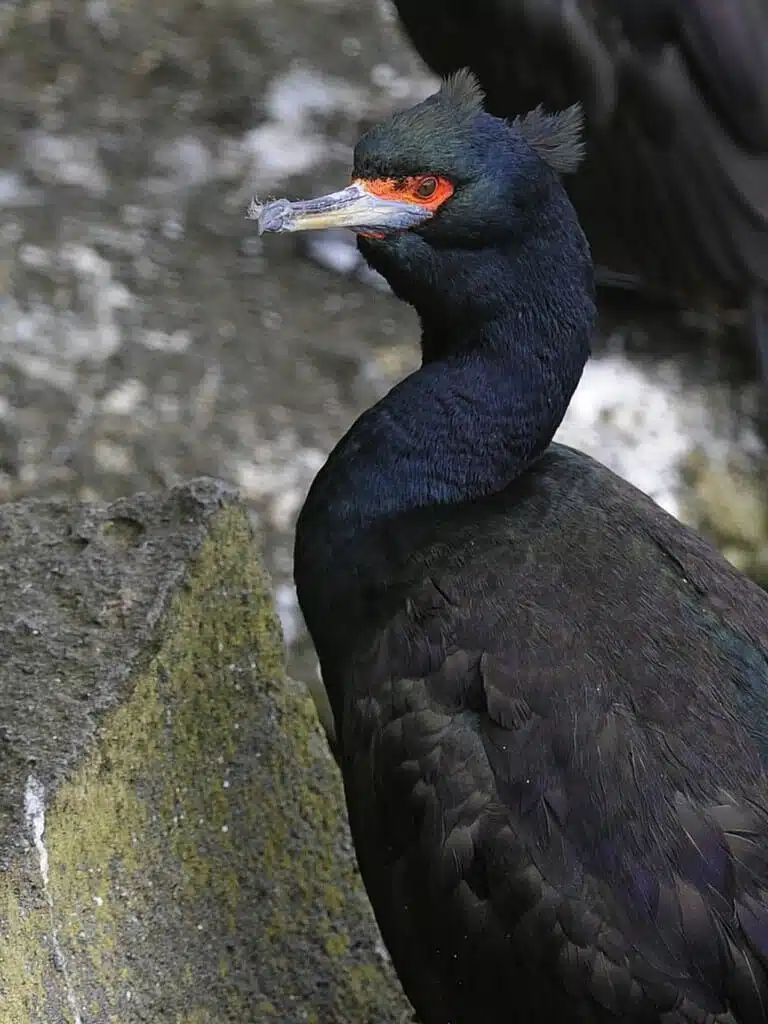
A dark green and blue cormorant, the Red-faced Cormorant (Urile urile) even appears black when not observed from a close distance.
Its name is derived from its vivid red face mask but its crown also shows 2 crests.
This type of cormorant is one of the birds with 2 crests which are only seen in the breeding season. One is located at the front of its head, closer to the eyes while the other one is spotted at the back of the head.
Both its crests have a black color and may be raised or lowered.
This species lowers the crest as it plunges for fish.
Red-faced Cormorants are very good divers, going down to the bottom of the water for fish species that only live at the bottom.
Their breeding sights are the only location where they can be spotted in groups, often with other species of cormorants.
Distribution – Northern Pacific
Crest color – black
32. Crested Auklet
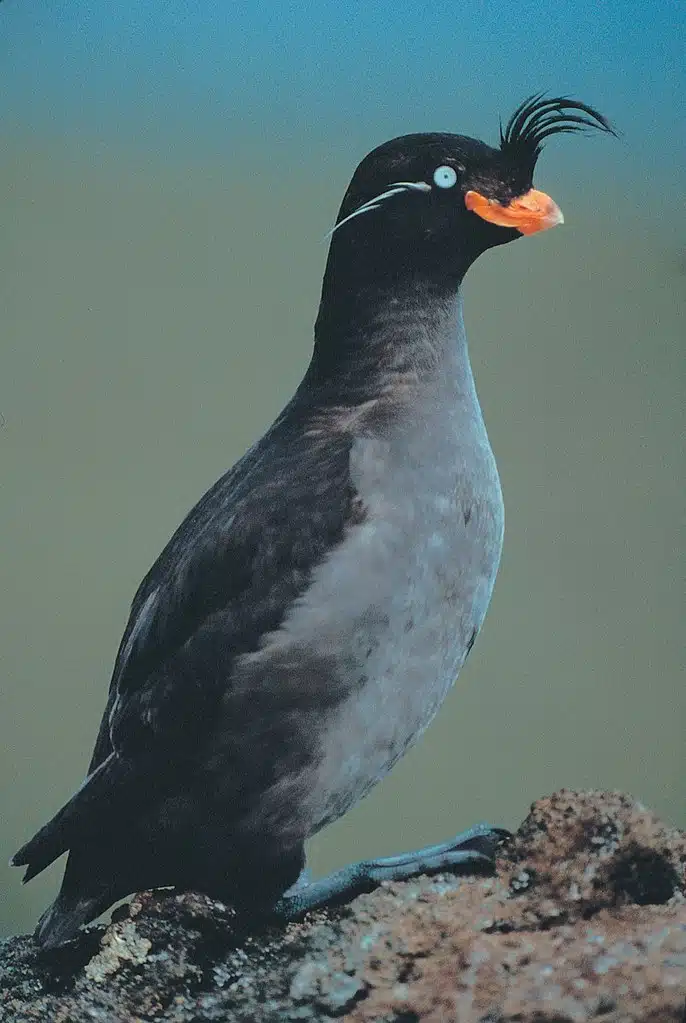
Crested Auklets (Aethia cristatella) are some of the most numerous crested birds in the world.
Almost 5 million Crested Auklets live around the world and half of them are in North America.
These types of birds are found in the North Pacific Coast. They have a long black crest at the front of the head which isn’t simply decorative, it marks their breeding strategies.
Both males and females have a long black crest. They select mating partners based on the length and appearance of the black crest.
Many females show a preference towards males with longer crests and may switch partners for mates with more impressive crests.
The habitat of these birds is very specific as they don’t like high water pollution.
Even more, they are dependent on krill, a type of crustaceans at the bottom of the food chain which is also rich in nutrients.
Distribution – Northern Pacific
Crest color – black
33. Oak Titmouse
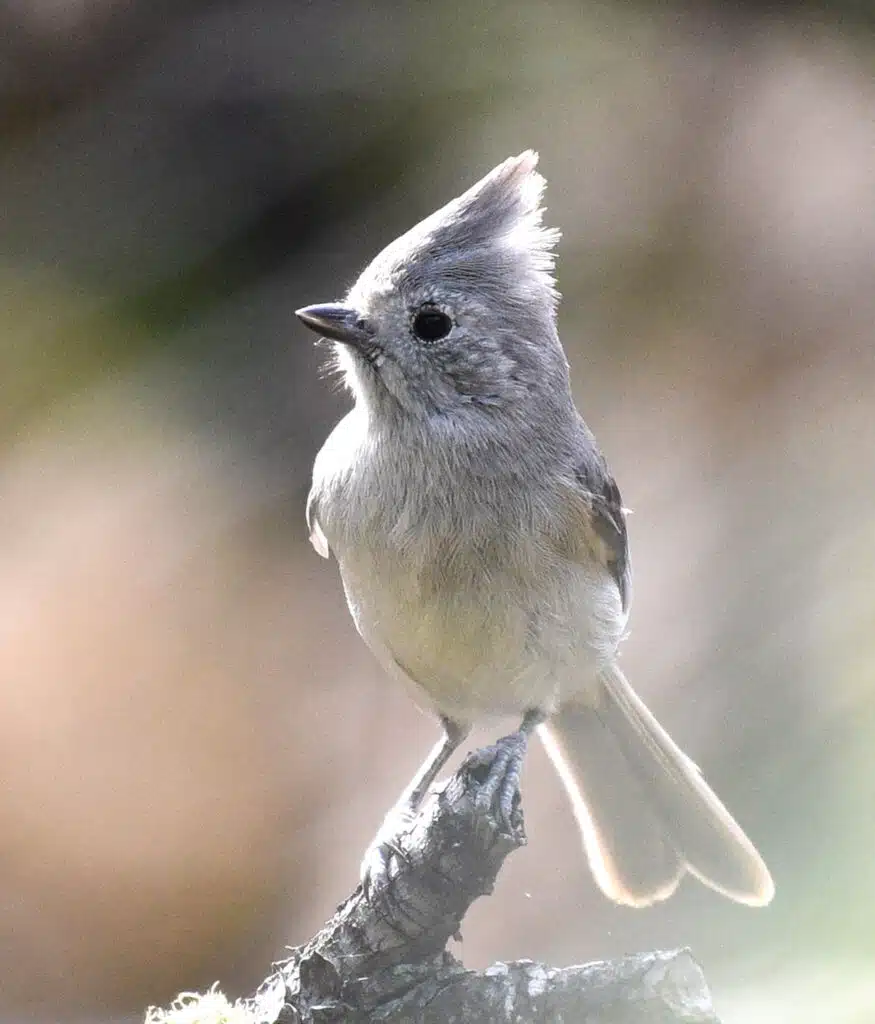
A short crest is seen on male and female Oak Titmouse (Baeolophus inornatus). These birds are dull-colored but still sexually dimorphic.
Males are mostly gray, with a gray crest. Females show additional brown sections along the body and have a bright brown crest.
Much of their range is limited to the Southwestern US territories.
This is where they live in woodlands, often sharing the trees they live on with other birds.
Even more, these small crested birds repurpose old nests and the holes in trees made by woodpeckers to make their own nests.
Oak Titmouse birds use various materials such as grass to line these holes and build their nests.
Highly active from March to April, the species is known to have a large clutch with up to 9 eggs.
While rare, male Oak Titmouse birds can take turns in the incubation period.
Distribution – Southwestern United States
Crest color – gray-brown
34. Ruffed Grouse
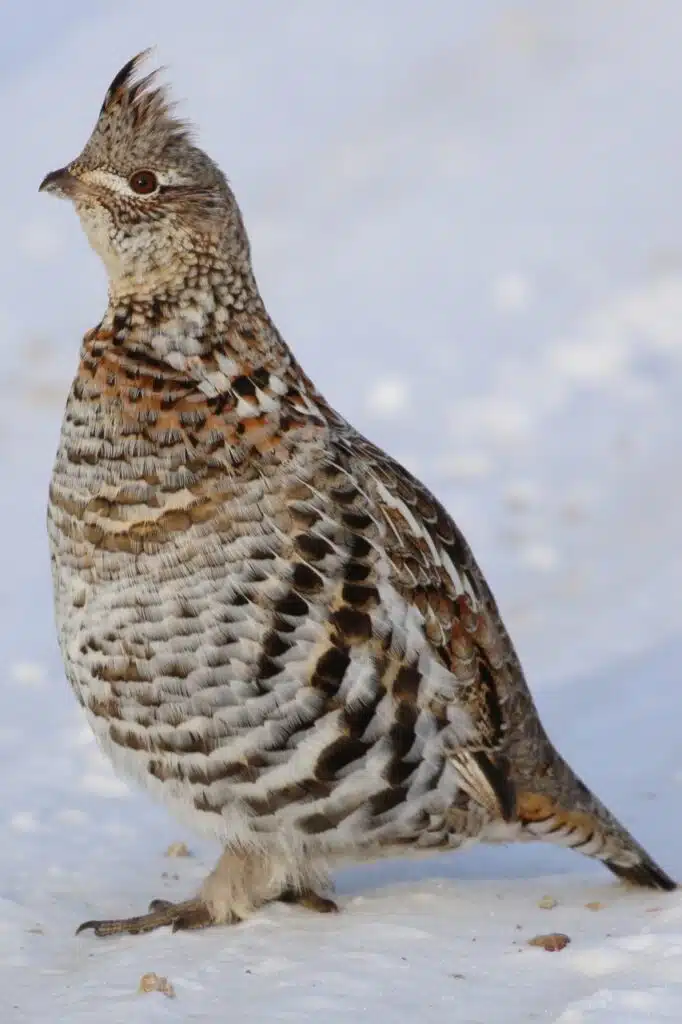
Ruffed Grouse (Bonasa umbellus) show a short crest both in the case of males and females.
These birds are highly similar in plumage and crest size as well as in weight, which may make it difficult to correctly identify males from females.
Ruffed Grouse spend their lives on the ground, looking for food. They are found in areas with aspen and they might only survive for a year in the wilderness.
These birds survive winters and are even known to bury themselves in deep snow.
Females of the species lay a cluster of up to 11 eggs which have a pale color and are laid directly on the ground.
A sheltered place such as a pile of dead leaves in the forest provides the typical nesting needs for the clutch.
These birds are known to rely on their habitat in sandy areas which they rub against to get rid of insects.
Distribution – Northern United States, Canada
Crest color – gray, brown, black
35. Rufous-crowned Sparrow
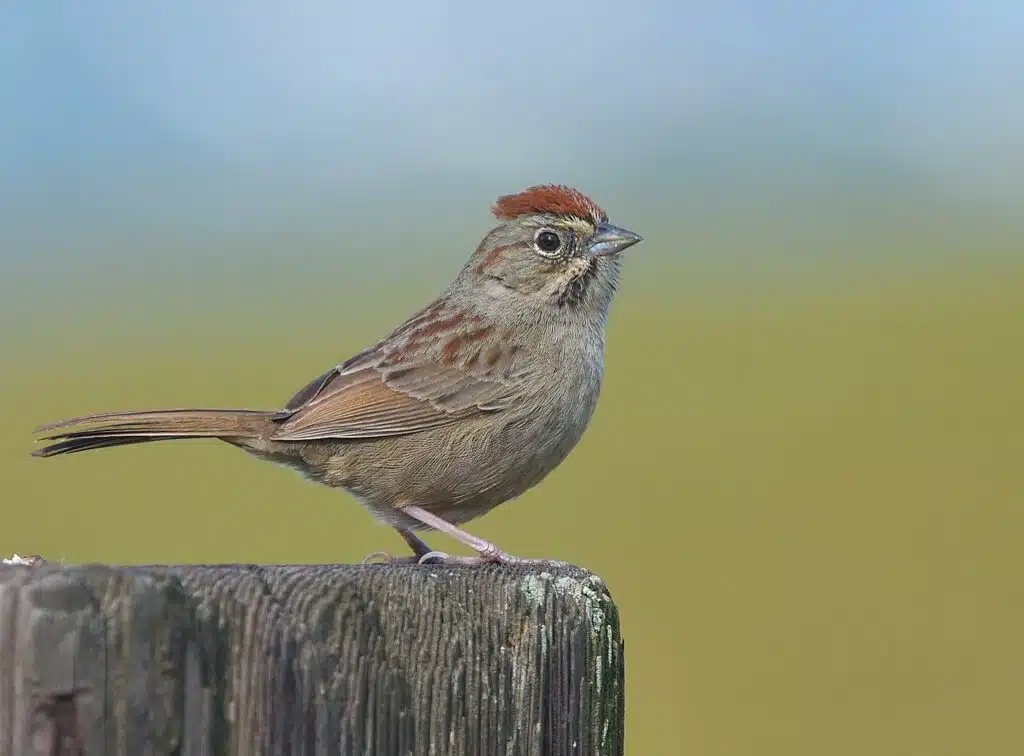
A short brown crest is seen on the Rufous-crowned Sparrow (Aimophila ruficeps).
A brown color is specific to the crest with additional brighter brown stripes along the eyes. Its plumage is mostly gray or gray-brown.
At least 12 subspecies of Rufous-crowned Sparrows are officially recognized today. Some of these subspecies are also found in North America.
Arizona and Texas are among the states its presence is confirmed.
A species also seen in Mexico, The Rufuous-crowned Sparrow lives in flocks. It often mixes with the flocks of other species, forming mixed flocks of up to several hundred birds.
Some of its preferred habitats include open woodlands.
Distribution – California, New Mexico, Arizona, Texas, Mexico
Crest color – brown
36. Scaled Quail
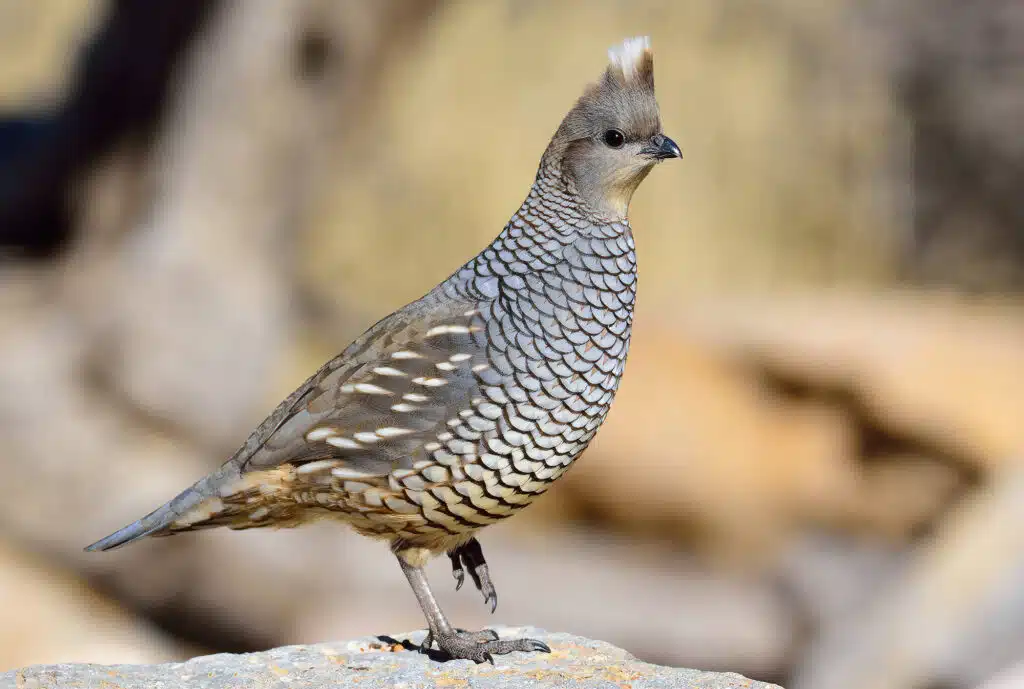
A species of desert grasslands, Scaled Quail (Callipepla squamata) are a type of bird with a white puffy crest.
The crest is the only pure-white section on the bird. Scaled Quails have bright gray plumage with a scale-like pattern.
This pattern is seen on its belly.
Females of the species may be spotted easily during the breeding season as they incubate.
Scaled Quail clutches are some of the largest among the birds with crests with up to 16 eggs laid at a time.
Also, native to The United States, Scaled Quails are known for their preference for running instead of flying.
Distribution – Arizona, New Mexico, Texas, Mexico
Crest color – white, brown
37. Mandarin Duck
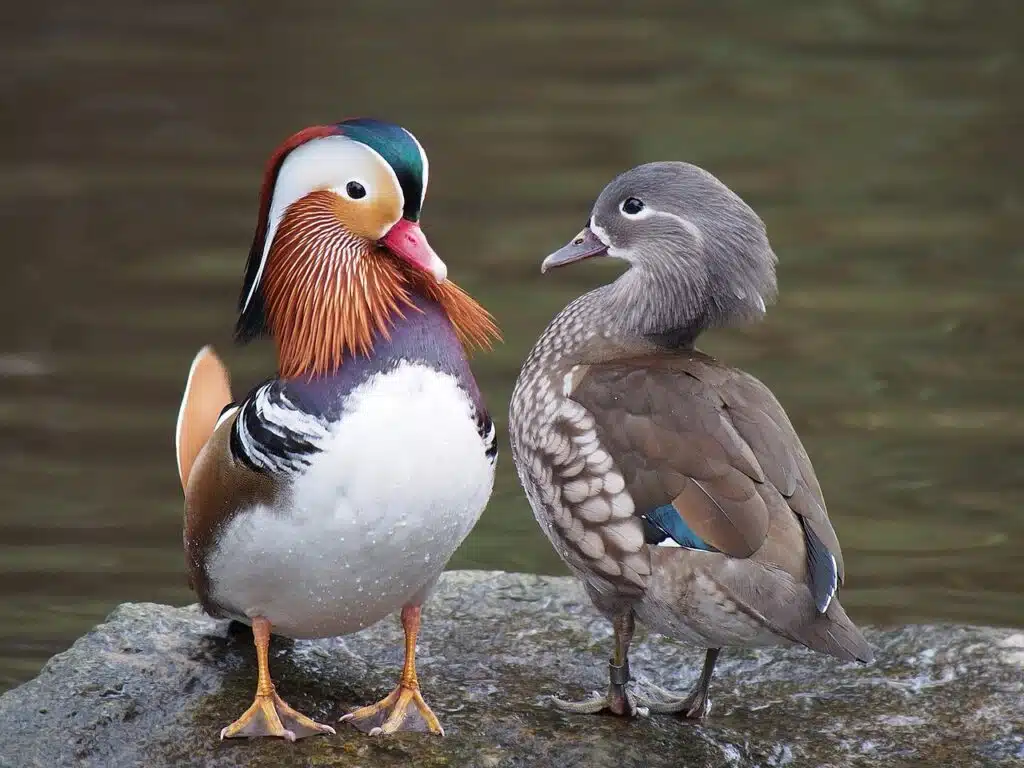
Male and female Mandarin Ducks (Aix galericulata) look highly similar up until the breeding season. These ducks are known for their crests, which are mostly visible in males in breeding plumages.
Males undergo molts during the breeding season and become white, brown, green, and purple. They show purple crests while females have gray crests.
Outside of the breeding season, these ducks have a similar dull color with the beak being one of the few differentiating factors between the sexes.
Females have a gray beak while males have a yellow-orange beak which also switches to a red color during the breeding season.
Distribution – East Asia
Crest color – gray, purple
38. Dusky-capped Flycatcher
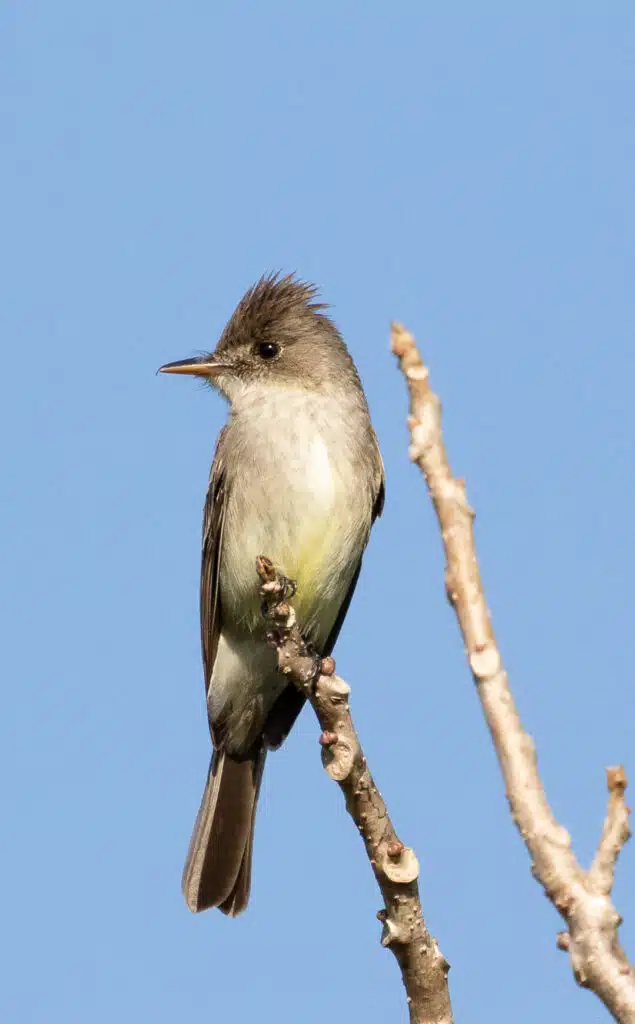
Dusky-capped Flycatchers (Myiarchus tuberculifer) are one of crested birds that are easy to spot due to their varied habitat.
This species is known for its presence in various mixed and hardwood forests, including humid forests. They also spread to gardens across multiple countries.
A dull brown and gray color combination is specific to the species. A small brown crest is seen on these birds which only have a colorful yellow patch on the underbelly.
Some Dusky-capped Flycatchers may also have black crests and heads.
Reaching a maximum size of just over 7 inches, Dusky-capped Flycatchers catch insects in flight.
Distribution – California, Arizona, New Mexico, Mexico, Nicaragua, Panama, Costa Rica, Venezuela, Colombia, Ecuador
Crest color – brown, black
39. Tufted Flycatcher
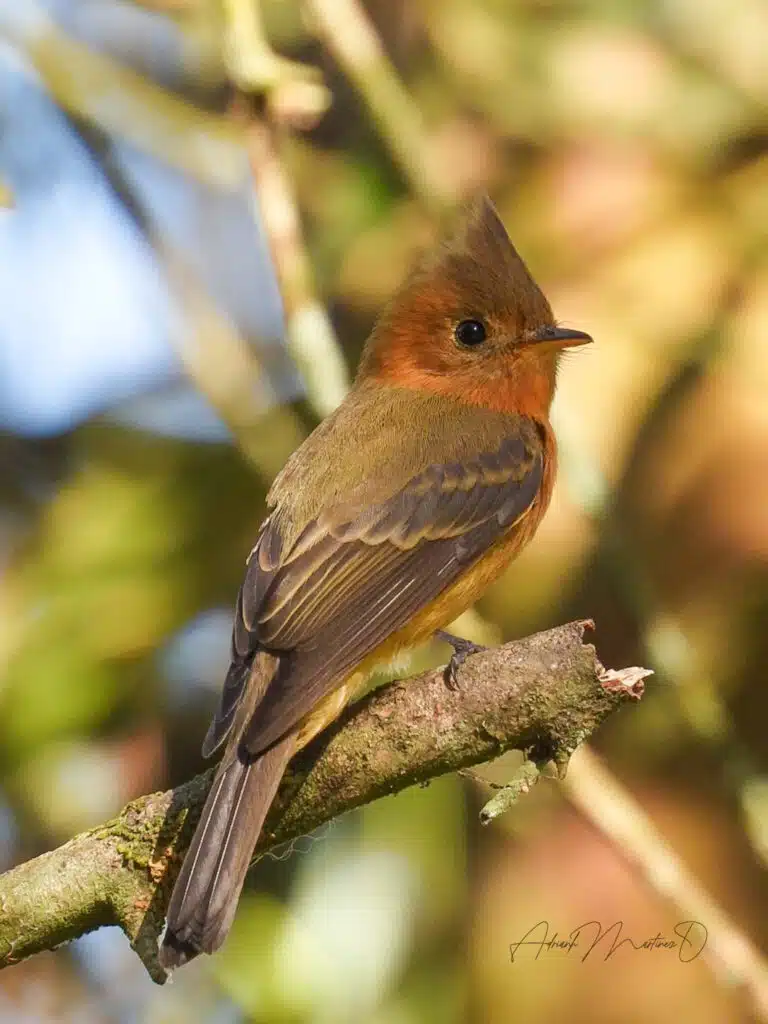
Tufted Flycatchers (Mitrephanes phaeocercus) are among the few birds with an olive crest. This type of nuance is also specific to its underbelly.
Young Tufted Flycatchers are brighter and dominated by various nuances of brown.
Specifically numerous in moist woodlands, this is a species which also shows various brown nuances on the sides of the head, as an adult.
Found at elevations of up to a few thousand feet, Tufted Flycatchers may have a brown, yellow-brown, or olive underbelly depending on their region.
Native to Central America, Tufted Flycatchers are often seen in West Texas’s Big Bend National Park, an area with a hot arid climate.
Distribution – West Texas, Mexico, Guatemala, Costa Rica, Nicaragua, Panama
Crest color – olive
40. Greater Crested Tern
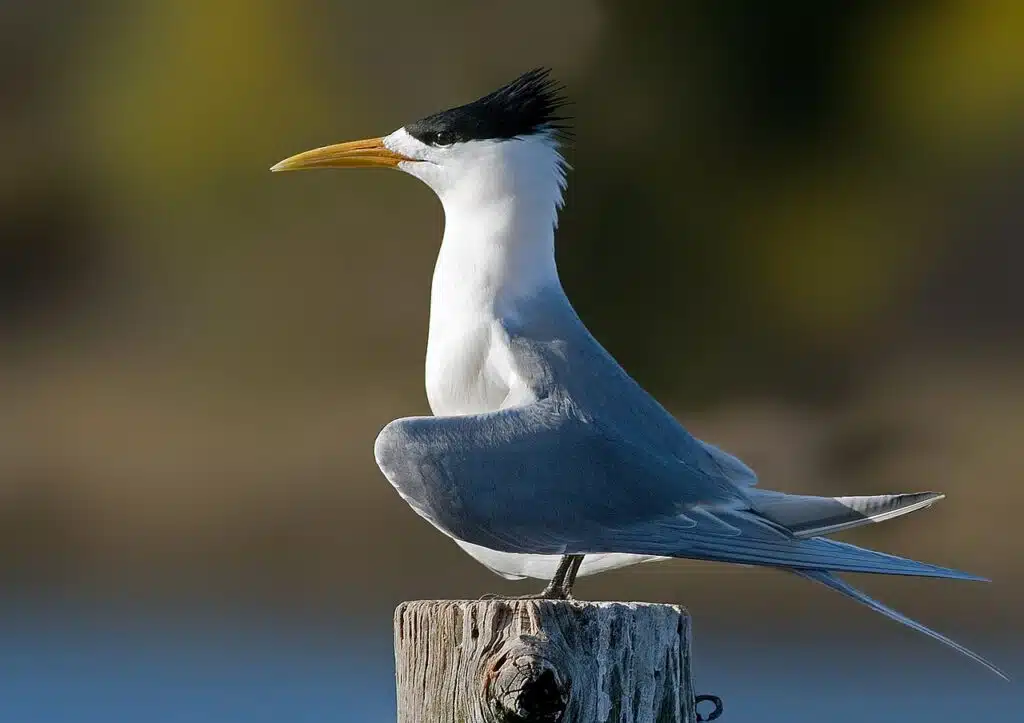
A long black crest is specific to The Greater Crested Tern (Thalasseus bergii). This species has a white head, a black crown, and a black crest.
Its underbelly is white while its wings are gray.
From the East Coast of Africa to Australia, this yellow-billed bird is generally not migratory.
Numerous in Australia, The Greater Crested Tern is known to eat fish. Ocean and lake pelagic fish are among its preferred foods.
Birds of the species breed in large colonies. They represent one of the minority species where both males and females take turns for incubation.
Distribution – East Africa, The Middle East, Southeast Asia, Australia, New Guinea
Crest color – black